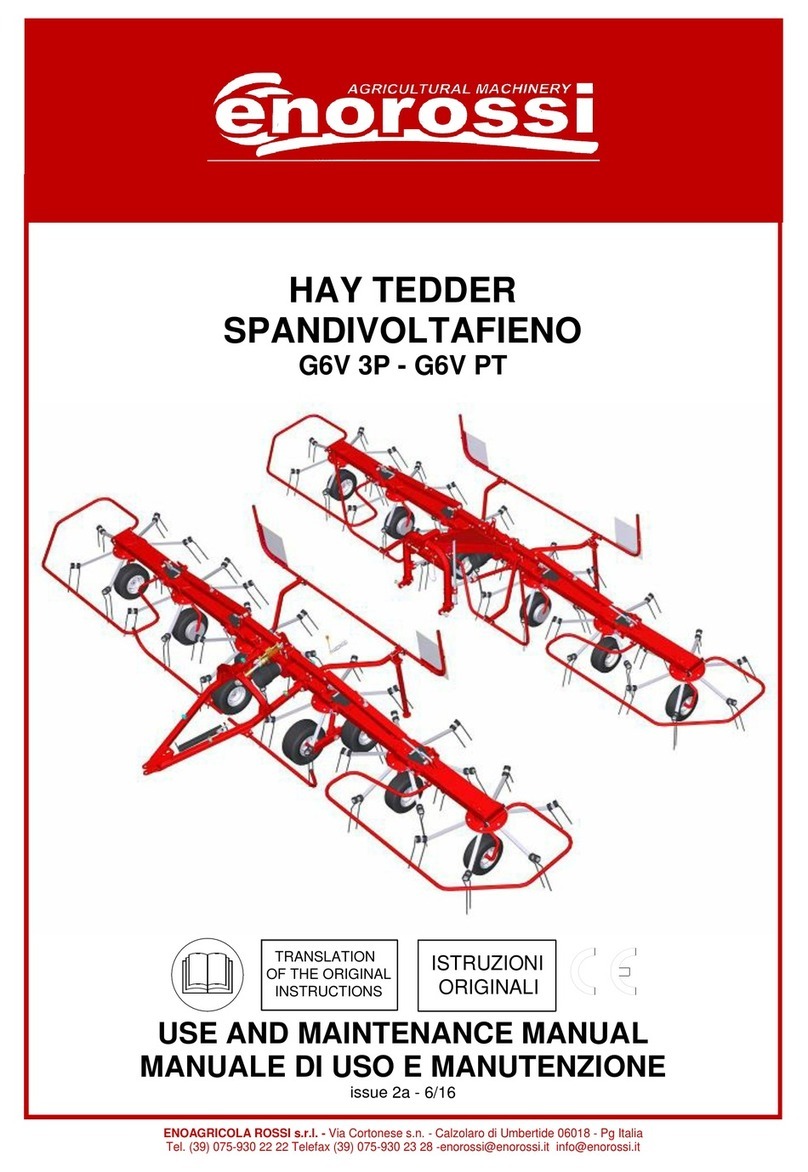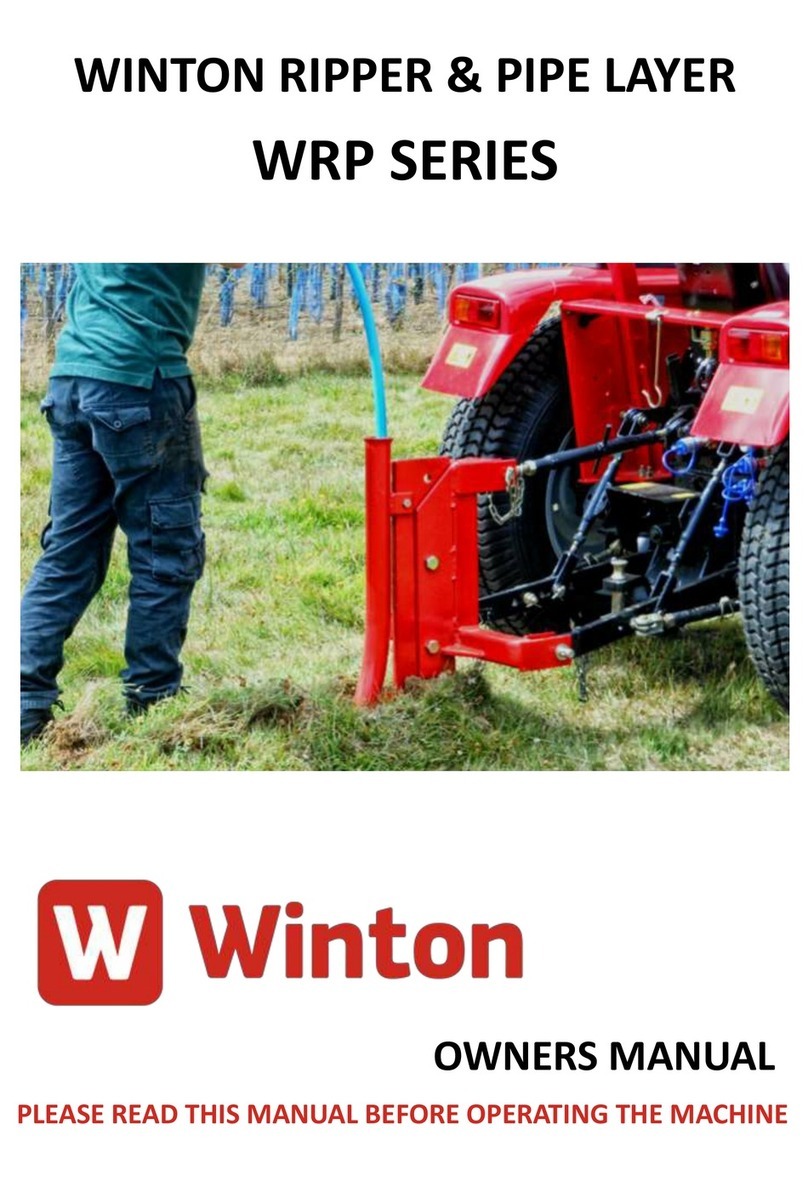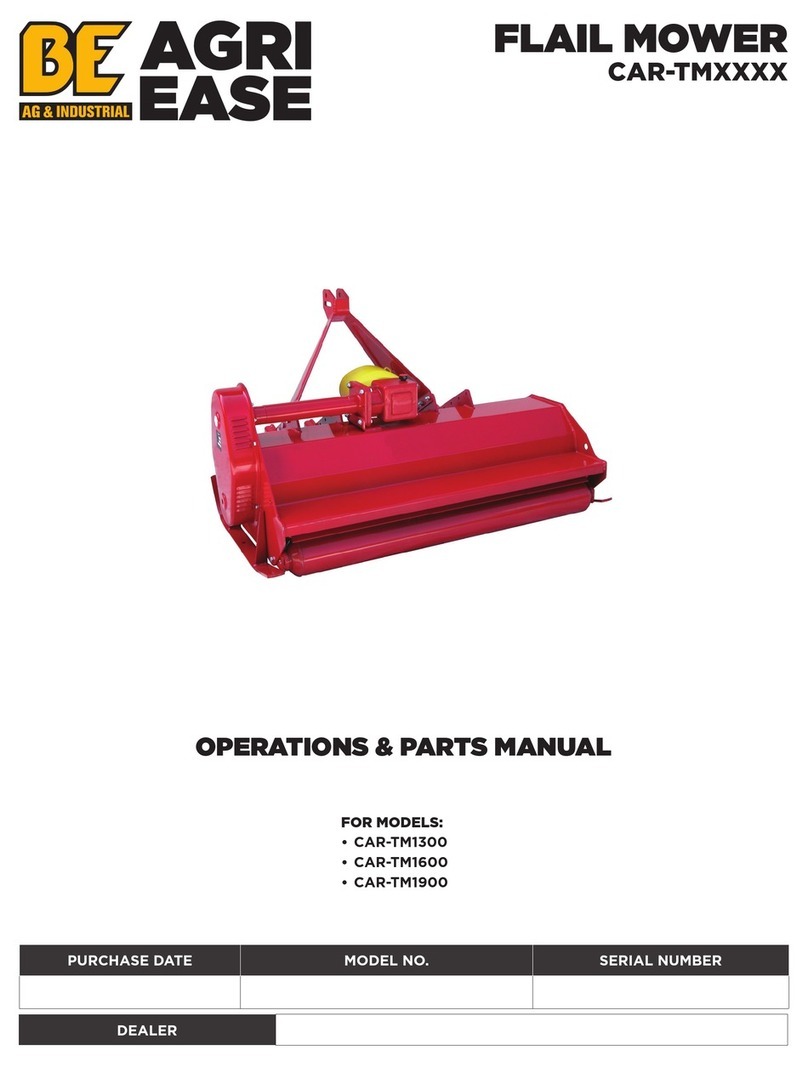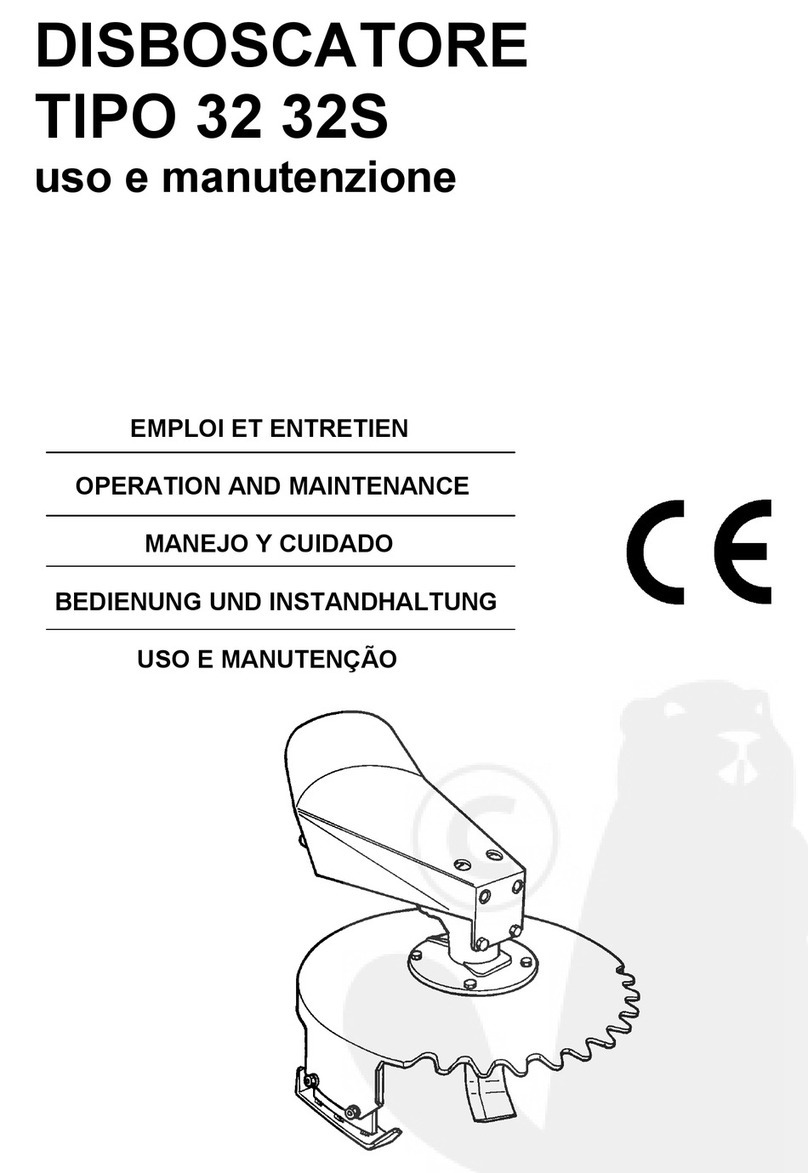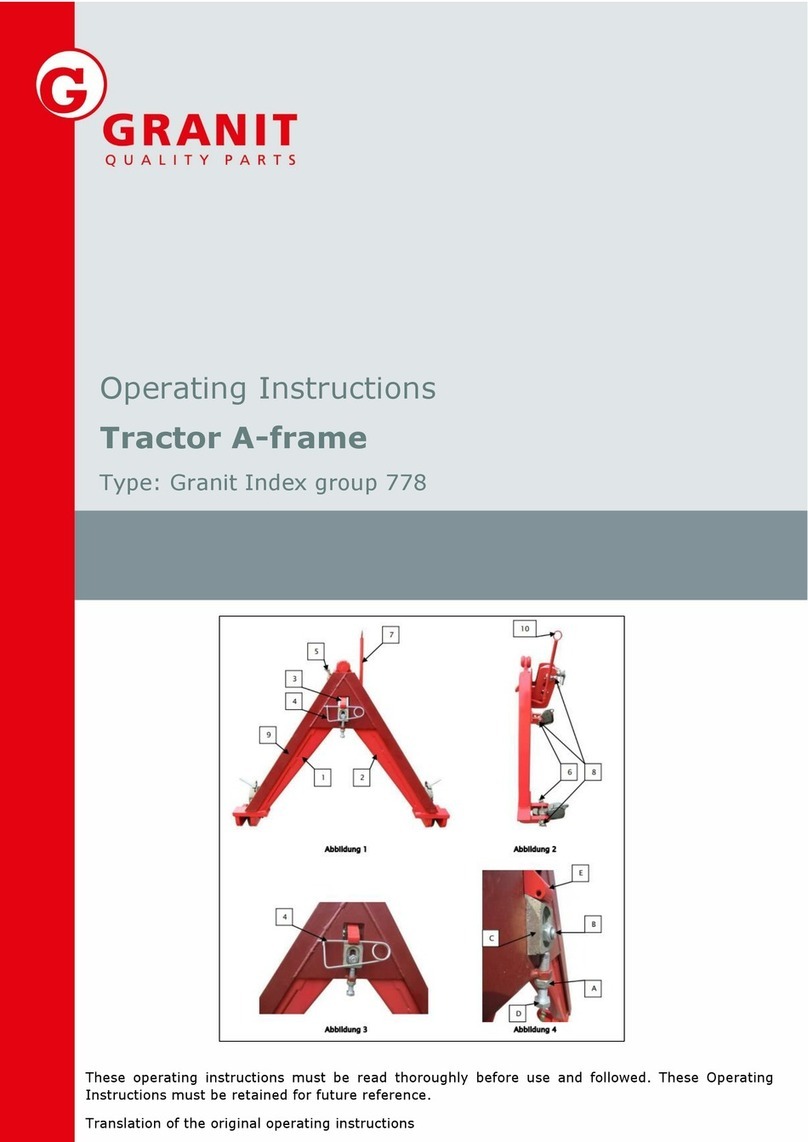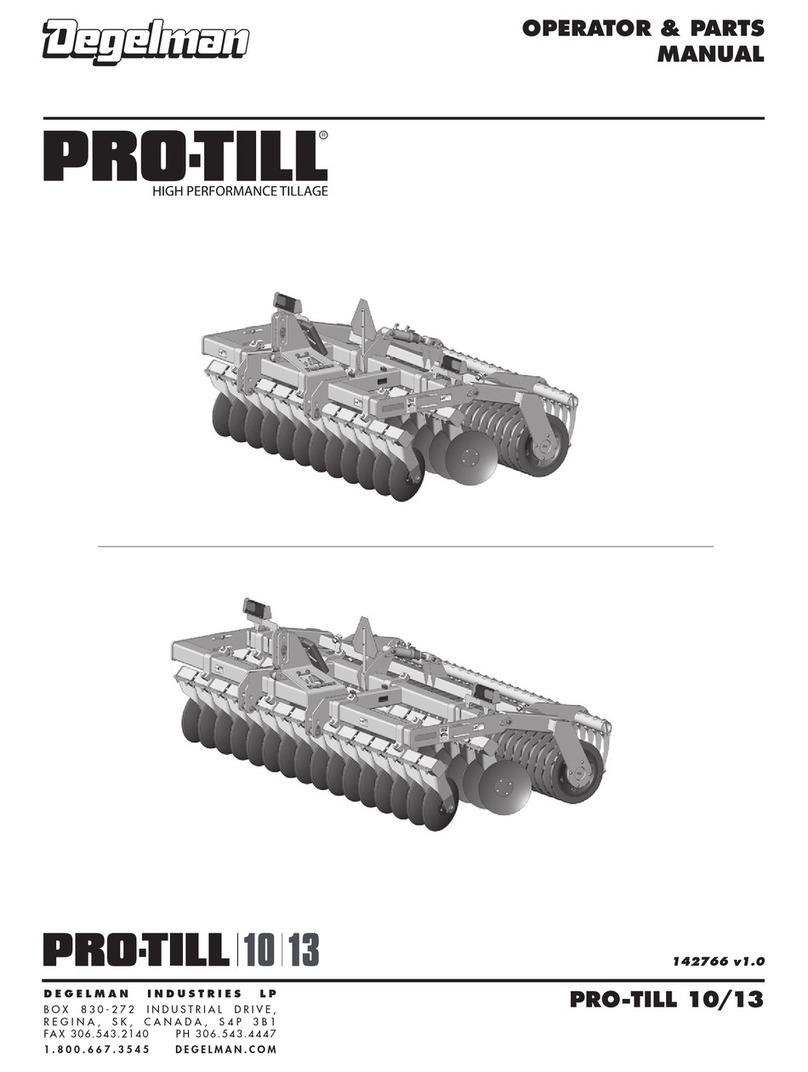enorossi G2V 310 3P/PT User manual

ENOAGRICOLA ROSSI s.r.l. - Via Cortonese, 36 - Calzolaro di Umbertide 06019 - Pg Italia Tel. (39) 075-930 22 22
G2V 310 3P/PT
Hay Tedder - Spandivoltafieno
USE AND MAINTENANCE MANUAL
MANUALE DI USO E MANUTENZIONE
Issue/rev. 6b - 10/2021
ISTRUZIONI
ORIGINALI
TRANSLATION
OF THE ORIGINAL
INSTRUCTIONS

ENOAGRICOLA ROSSI s.r.l.
Via Cortonese s.n
Calzolaro di Umbertide 06019 Pg Italia
Tel. (39) 075-930 22 22 - Telefax (39) 075-930 23 28
EC DECLARATION
OF CONFORMITY
(Annex IIA Machinery Directives 2006/42/EC)
DICHIARAZIONE CE
DI CONFORMITÀ
(All.IIA Direttiva Macchine 2006/42/CE)
The Manufacturer ENOAGRICOLA ROSSI s.r.l.
with head office in via Cortonese, 36 –
06019 Calzolaro di Umbertide (PG) - Italy
declares under its own responsibility
that the machine
Il Fabbricante ENOAGRICOLA ROSSI s.r.l.
con sede in via Cortonese, 36 - 06019
Calzolaro di Umbertide (PG) - Italia
dichiara sotto la propria responsabilità
che la macchina
whose functions are described in this manual
is conform to the Essential Requirements of Safety and
Health Protection, as per Machinery Directive 2006/42/EC
and to those ones of Directive 94/20/CE relating to the
mechanical coupling devices of motor vehicles and their
trailers and their attachment to those vehicles
To check the conformity of the Directives mentioned
up here, the following EN Harmonized Standards
have been consulted:
le cui funzioni sono descritte in questo manuale
è conforme ai requisiti essenziali di Sicurezza e di Tutela
della Salute di cui alla Direttiva Macchine 2006/42/CE e
(per il tipo trainato) alla direttiva 94/20/CE concernente i
dispositivi di attacco meccanico dei veicoli a motore e
dei loro rimorchi ed il loro agganciamento a detti veicoli
Per la verifica della Conformità di cui alle Direttive
sopra menzionate, sono state consultate le seguenti
Norme Armonizzate EN:
EN ISO 4254-1:2015 - EN ISO 4254-10:2010
EN ISO 4413:2012 - ISO 11684 (1995) - EN 12100:2010
EN ISO 12965:2020 - EN ISO 13857:2020
and he authorizes Enorossi
via Cortonese, 36 - 06019
Calzolaro di Umbertide (PG) - Italy
to compile the relevant technical documentation
E autorizza Enorossi
Via Cortonese, 36 - 06019
Calzolaro di Umbertide (PG) - Italia
a costituire il Fascicolo Tecnico per suo conto
GIOVANNINI ADELMO
Calzolaro di Umbertide, …….. ……. …… ….……………………….
Legal representative - Legale rappresentante
HAY TEDDER - SPANDIVOLTAFIENO
……………………………………………………………………………………….…………………………………..
Generic denomination and commercial name - Denominazione generica e commerciale
G2V
…………………………..
Series/Model - Serie/Modello
….
……………………………………………
Serial number –Matricola
20..
…………….
Manufacturing year
Anno costruzione

3
CONTENT - INDICE
EC DECLARATION OF CONFORMITY
2
DICHIARAZIONE CE DI CONFORMITÀ
2
INTRODUCTION
5
INTRODUZIONE
5
INFORMATIONS ABOUT THE MANUAL
5
INFORMAZIONI SUL MANUALE
5
IDENTIFICATION AND EC CERTIFICATION
6
IDENTIFICAZIONE E CERTIFICAZIONI CE
6
MAIN COMPONENTS AND TECHNICAL DATA
7
COMPONENTI PRINCIPALI E DATI TECNICI
7
WARRANTY
8
GARANZIA
8
SAFETY
10
SICUREZZA
10
GENERAL RULES
10
NORME GENERALI
10
SAFETY DURING TRANSPORT, INSTALLATION AND
MOVEMENTS
10
SICUREZZE CIRCA IL TRASPORTO,
L’INSTALLAZIONE E GLI SPOSTAMENTI
10
INTENDED USE AND WARNINGS OF EMPLOY
13
USO PREVISTO E AVVERTENZE NELL’IMPIEGO
13
REASONABLY FORESEEABLE MISUSE AND LIMIT
OF EMPLOY
16
USO SCORRETTO RAGIONEVOLMENTE
PREVEDIBILE E LIMITI D’IMPIEGO
16
RESPONSIBILITY OF THE OPERATOR
17
RESPONSABILITÀ DELL’OPERATORE
17
PICTOGRAMS
18
PITTOGRAMMI
18
NOISE LEVEL
19
RUMOROSITÀ
19
RESIDUAL RISKS
19
RISCHI RESIDUI
19
INSTALLATION
20
INSTALLAZIONE
20
PRELIMINARY INFORMATIONS
20
INFORMAZIONI PRELIMINARI
20
INSTALLATION TO TRACTOR
20
INSTALLAZIONE AL TRATTORE
20
CARDAN SHAFT ADAPTATION AND INSTALLATION
22
INSTALLAZIONE ED ADATTAMENTO ALBERO
CARDANICO
22
REMOVAL
23
RIMOZIONE
23
STORAGE OF HAY TEDDER
23
IMMAGAZZINAMENTO DELLO SPANDIVOLTAFIENO
23
OPERATION AND USE
25
FUNZIONAMENTO ED USO
25
PRELIMINARY INFORMATIONS
25
INFORMAZIONI PRELIMINARI
25
WORKING CONFIGURATION
25
CONFIGURAZIONE DA LAVORO
25
WORKING PROCESS
26
PROCESSO LAVORATIVO
26
ADJUSTMENT OF ROTARY UNIT TILT
26
REGOLAZIONE DELL’INCLINAZIONE DEI GRUPPI
ROTATIVI
26
CHANGE OF DIRECTION OF REVERSE
27
CAMBIO DI DIREZIONE O RETROMARCIA
27
TRANSPORT CONFIGURATION
27
CONFIGURAZIONE DA TRASPORTO
27
END OF WORK
27
TERMINE LAVORO
27
MAINTENANCE
28
MANUTENZIONE
28
PRECAUTIONS DURING MAINTENANCE
28
AVVERTENZE IN FASE DI MANUTENZIONE
28
MAINTENANCE TASKS
29
INTERVENTI DI MANUTENZIONE
29
TINE REPLACEMENT
30
SOSTITUZIONE DENTI
30
TROUBLESHOOTING
31
RICERCA GUASTI
31
MATERIAL DISPOSAL IN CASE OF DEMOLITION
31
SMALTIMENTO MATERIALI IN CASO DI
DEMOLIZIONE
31
SERVICE PARTS
33
RICAMBI
33

4
Machine Directive and Harmonized standards
The hay tedders have been designed according to the
Machinery Directive EC/2006/42 rules and meets the
following harmonized standards:
EN ISO 4254-1:2015Agricultural machines - self-propelled,
mounted, semi-mounted and pulled type agricultural
machines - Common safety requirements
EN ISO 4254-10:2010 Agricultural machines - self-propelled,
mounted, semi-mounted and pulled type agricultural
machines - Safety - Part 10: Hay rake and Hay tedder
EN ISO 4413:2012 Hydraulic fluid power - General rules and
safety requirements for systems and their components.
ISO 11684: Tractors, forestry and agricultural machinery,
gardening motor machines - Safety graphic symbols and
hazards indication pictograms - General Principles (1995)
EN 12100:2010 Safety of Machinery - General principles of
design - Risk assessment and risk reduction
EN 12965:2020 Tractors and agricultural machinery and
forestry. Power Take-Off (PTO) shafts and guards. Safety
EN 13857:2020 Machinery safety - Safety distances to keep
dangerous areas out of reach
ISO 3600:2015: Tractors, machinery for agriculture and
forestry, powered lawn and garden equipment - Operator's
manuals - Content and presentation
All rights reserved. Reproduction of any part of this manual, in
any form without the express written permission of
ENOROSSI, is prohibited. The contents of this manual can be
modified only by the manufacturer and without notice to the
Customer.
Direttiva Macchine e Norme armonizzate
Gli spandivoltafieno sono stati progettati seguendo le norme
descritte nella Direttiva Macchine 2006/42CE ed in
particolare soddisfano le seguenti Norme armonizzate:
EN ISO 4254-1:2015Macchine agricole - Macchine agricole
semoventi, portate, semiportate e trainate - Requisiti comuni
di sicurezza
EN ISO 4254-10:2010 Macchine agricole - Macchine
agricole semoventi, portate, semiportate e trainate -
Sicurezza - Parte 10: Ranghinatori e Spandivoltafieno (2010)
EN ISO 4413:2012 Oleoidraulica - Regole generali e requisiti
di sicurezza per i sistemi e i loro componenti.
ISO 11684: Trattrici, macchine agricole e forestali, macchine
a motore da giardinaggio - Segni grafici per la sicurezza e
pittogrammi di segnalazione dei pericoli - Principi generali
(1995)
EN 12100:2010 Sicurezza del macchinario - Principi generali
di progettazione - Valutazione del rischio e riduzione del
rischio
EN 12965:2020 Trattori e macchine per l'agricoltura e la
silvicoltura. Presa di forza (PTO), alberi di trasmissione e le
loro guardie. Sicurezza
EN 13857:2020 Sicurezza del macchinario - Distanze di
sicurezza per impedire il raggiungimento di zone pericolose
con gli arti inferiori
ISO 3600:2015: Trattrici e macchine agricole e forestali,
attrezzature per prato e giardino dotate di motore -
Contenuto e presentazione
Tutti i diritti sono riservati. È vietata la riproduzione di
qualsiasi parte di questo manuale, in qualsiasi forma, senza
l’esplicito permesso scritto della ENOROSSI. Il contenuto di
questo manuale può essere modificato soltanto dalla ditta
costruttrice e senza preavviso al Cliente.

5
INTRODUCTION
Informations about the manual
ENOROSSI (hereinafter named "Manufacturer") has
designed and built the equipment in compliance with
the safety regulations and with the precise intent of
protecting both the personnel at work and the entire
operating system.
Each hay tedder is equipped with a copy of this
manual, which should be read carefully before using
the equipment. The manual contains the necessary
information for the equipment transport, use and
maintenance and the corresponding safety regulations.
The lack of knowledge of its operating system could
cause accidents that may cause damage to the
equipment. Therefore, even if at the moment of
delivery, the Manufacturer gives to the Customer all
the information concerning the hay tedder (operation,
use and maintenance), he must, however, read this
manual and follow the instructions contained therein.
The manual gives the basic guidelines for the best
working conditions and safety, but the operator's
experience and common sense remains the most
important factor for the equipment operation.
This manual was created according to existing hay
tedder models specifications and design and does not
take into account the similar models previously
produced. However, the Manufacturer reserves the
right to make changes to the models in production, in
order to improve the product or where new regulations
were enacted (Machinery Directive), without the
obligation to update the previously built models.
This manual is part of the hay tedder and, therefore,
should be kept, clean and intact in all its parts and
stored in a special container, placed on the equipment
frame or inside the tractor cabin, ready for any
consultation.
In the case of sale of the hay tedder, it is important to
check that the manual is present. If the manual is
missing, a duplicate must be requested to the
Manufacturer.
If while reading the manual the instructions are
incomprehensible, you should contact the
Manufacturer, which will provide the necessary
clarifications. If the manual is translated into another
language, and part of its contents lead to disputes, the
valid reference texts remains the one written in Italian.
INTRODUZIONE
Informazioni sul manuale
La ditta ENOROSSI (di seguito denominata
“Fabbricante”) ha progettato e realizzato l’attrezzatura
nel rispetto di appropriate norme di sicurezza con il
preciso intento di salvaguardare sia il personale che vi
opera intorno che l’intero sistema operativo.
Ogni spandivoltafieno viene fornito di una copia di
questo manuale, che deve essere letto attentamente
prima che lo stesso venga utilizzato. Nel manuale
sono contenute le informazioni necessarie per il
trasporto, l’impiego e la manutenzione dell’attrezzatura
nonché le relative norme di sicurezza.
La mancata conoscenza del suo sistema operativo
potrebbe provocare incidenti, con conseguenti danni
alla stessa attrezzatura. Pertanto, anche se al
momento della consegna il Fabbricante fornisce al
Cliente tutte le informazioni relative allo spandi-
voltafieno (funzionamento, uso e manutenzione),
questi è tenuto, comunque, a leggere il presente ma-
nuale e ad osservare le istruzioni in esso contenute.
Il manuale fornisce le indicazioni di base per ottenere
le migliori condizioni di lavoro e di sicurezza ma resta
comunque l'esperienza ed il buon senso dell'operatore
il fattore più importante per il funzionamento
dell’attrezzatura.
La stesura del manuale è stata eseguita in base alle
caratteristiche tecniche e costruttive degli attuali
modelli di spandivoltafieno e non tiene conto dei
modelli simili prodotti in precedenza. Tuttavia, il
Fabbricante si riserva il diritto di apportare modifiche ai
modelli in produzione, al fine di migliorarne il prodotto
o qualora venissero emanate nuove disposizioni in
materia (Direttiva Macchine), senza l’obbligo di
adeguare i modelli costruiti in precedenza.
Il presente manuale costituisce parte integrante dello
spandivoltafieno e, perciò, deve essere bene
conservato, pulito ed integro in tutte le sue parti e
custodito in un apposito contenitore, posto sul telaio
dell’attrezzatura o all’interno della cabina del trattore,
pronto per ogni consultazione.
In caso di cessione del spandivoltafieno sarà
importante verificare che il manuale sia presente nella
sua custodia. Nel caso esso fosse andato disperso,
sarà necessario chiederne un duplicato al Fabbricante.
Se durante la lettura del manuale le istruzioni
risultassero incomprensibili, è opportuno contattare il
Fabbricante, che fornirà gli opportuni chiarimenti.
Qualora il manuale fosse tradotto in un’altra lingua e
parte del suo contenuto dovesse dare adito a
controversie, il testo valido di riferimento rimane quello
scritto in lingua italiana.

6
Warnings in this manual:
IMPORTANT
To indicate that the information must be absolutely
known by the operator;
HAZARD
To indicate a possible hazardous situation which
concerns the operator and others' safety (minor
accidents or injuries), or concerns the hay tedder
efficiency;
Note: indicates the topic can facilitate the operator
work.
Identification and EC certifications
Each hay tedder has a clearly visible identification plate
applied on the frame where the following data are
marked:
-the hay tedder model (and/or version);
-serial number;
-manufacturing year.
These data are to be cited
for every need of assistance
and spare parts
IMPORTANT
It is absolutely forbidden to
alter and/or delete the data
on the identification plate.
The operator is required to
verify the readability of
data, and when this results
precarious, to notify it to the
Manufacturer who will
replace the plate with a new, copying all the data on it.
The CE mark indicates that the Manufacturer has
complied with the States Member of the European
Community provisions, adopted on safety and health
requirements and known as "Machinery Directive".
This means that the Manufacturer has designed and
built the equipment in full compliance with all the
requirements and in order to avoid all possible risks
and dangers. Therefore, the hay tedder can circulate
freely within European territory only if equipped with
this brand and with its compliance declaration.
Segnalazioni contenute nel manuale:
IMPORTANTE
Per segnalare che le informazioni riportate devono
essere assolutamente conosciute dall’operatore;
PERICOLO
Per segnalare una probabile situazione di pericolo
che riguarda l’incolumità dell’operatore ed altrui
(lievi infortuni o ferite) o che riguarda l’efficienza
dello spandivoltafieno;
La scritta Nota indica che l’argomento trattato può
agevolare il lavoro svolto dall’operatore.
Identificazione e certificazioni CE
Ogni attrezzatura è dotata di una targhetta d’iden-
tificazione, applicata sul telaio e bene in vista, su cui
sono riportati i seguenti dati:
-il modello (e/o versione) dello spandivoltafieno;
-numero di matricola;
-anno di costruzione.
Tali dati dovranno essere
citati per ogni necessità di
assistenza e di ricambi.
IMPORTANTE
È assolutamente vietato
alterare e/o cancellare i dati
riportati sulla targhetta
d’identificazione. Ad ogni
modo, l’operatore è tenuto a
verificare spesso la
leggibilità dei dati e, quando
questa risulterà precaria, a
comunicarlo al Fabbricante.
Questi provvederà a
riportare i dati su una nuova targhetta e a sostituire
quella precedente.
Il marchio CE indica che il Fabbricante si è adeguato
alle disposizioni che gli Stati membri della Comunità
Europea hanno adottato sulla sicurezza e sulla salute
in materia e che è nota come “Direttiva macchine”.
Ciò significa che il Fabbricante ha progettato e
costruito l’attrezzatura nel pieno rispetto di tutti i
requisiti richiesti per il suo utilizzo e per evitare tutti i
possibili rischi e pericoli derivanti. Pertanto, lo
spandivoltafieno può circolare liberamente nel territorio
europeo solo se munito di questo marchio e della
relativa dichiarazione di conformità.
Type: XXXXXXXX Model
Serial N. XXXXXXX-XX
MFG: 2015 DEL: 2015
Enoagricola Rossi S.R.L.
Calzolaro di Umbertide - Perugia
Made in Italy

7
Main components and technical data
Componenti principali e dati tecnici
1.
Three-point universal hitch
2.
Cardan shaft coupling
3.
Protective lateral screens
4.
Rotary unit
5.
Tine holder arms
6.
Bearing wheel
7.
Tine
8.
Chassis
9.
Bearing foot
10.
Grade adjusting lever
11.
Towing bar
1.
Attacco universale a tre punti
2.
Attacco innesto albero cardanico
3.
Schermi di protezione anteriori e laterali
4.
Gruppo rotativo di lavoro
5.
Bracci porta-denti
6.
Ruotino di appoggio
7.
Dente
8.
Telaio
9.
Piedino di sostegno
10.
leva di regolazione inclinazione
11.
Barra di traino
TECHNICAL SPECIFICATIONS / CARATTERISTICHE TECNICHE
G2V 3P
G2V PT
Working width / Larghezza di lavoro
cm./ ft
310 / 10.2
310 / 10.2
Transport width / Larghezza di trasporto
cm./ ft
250 / 8.2
250 / 8.2
Tine holder arms / Bracci portadenti
nr.
12
12
Tines - Total / Denti / totale
nr.
12
12
PTO speed / Giri presa di forza
rpm
540
540
Tractor power / Potenza trattore
Hp
20
20
Tractor working speed / Velocità trattore avanzamento di lavoro
km/h
5÷10
5÷10
Cardan shaft with torque limiter / Albero cardanico con limitatore di coppia
Nm
600
600
Tires mounted on chassis / Pneumatici montati su telaio - Ballon 15.600-6
nr.
2
2
Weight / Peso dell’attrezzatura
Kg / lbs
190 / 419
193 / 425

8
Warranty
Enorossi (referred as Manufacturer) warrants that the
hay tedder is free from defects in each component, as it
undergoes testing before it is delivered to the
Customer. The one-year warranty is valid from the
delivery date indicated in the receipt, unless
different agreements signed with the Customer.
However, the Customer, upon receiving the hay tedder,
must make sure it is intact and complete in all its parts.
Any complaints must be received by the Manufacturer,
in writing, within 8 days from the equipment delivery.
Within the warranty period Enorossi will replace, free of
charge and at its headquarters, all the components that
due to defects in workmanship or materials, give rise to
incorrect operation. In the impossibility of replacement at
its headquarters, the Manufacturer agrees to send to the
Customer headquarters the defective parts. On these
replacements, Enorossi does not extend the warranty
period for the time during which the hay tedder remains
stationary, nor recognizes any compensation or
indemnity to the Customer for any direct or indirect
expenses or damages. If a technician intervention is
required, the cost of labor, travel and subsistence will be
paid by the Customer. The verification of the defect can
only be made by the Manufacturer or by technical
personnel hired from the Manufacturer.
However it is important to note that:
the defective parts remain property of the Manufacturer;
•if the replacement took place at the Customer
premises, the defective parts must be returned to
the Manufacturer, to be subjected to technical
examination, intact, without tampering and carriage
paid;
•in the event that the defective parts were not
returned to the Manufacturer within 30 days from
the date of delivery of the new ones and in the
manner described in the previous paragraph, the
Manufacturer reserves the right to send invoice for
the new parts sent.
The warranty is not valid:
•during transport as the hay tedder travels under the
Customer’s responsibility;
•when damages are caused by improper use of the
hay tedder or by the operator’s negligence;
•when damages are caused by normal wear even if
the tedder is not operating;
Garanzia
La ditta Enorossi (denominata Fabbricante) garantisce
che lo spandivoltafieno è esente da difetti in ogni suo
componente, in quanto lo sottopone a collaudo prima di
consegnarlo al Cliente. La garanzia ha validità 1 anno
a partire dalla data indicata nel documento fiscale
di consegna, salvo diversi accordi sottoscritti con il
Cliente.
Ad ogni modo, questi, al ricevimento dello
spandivoltafieno, deve verificare che lo stesso sia
integro e completo in ogni sua parte. Eventuali reclami
dovranno pervenire al Fabbricante, per iscritto, entro 8
giorni dal ricevimento dell’attrezza-tura.
Entro il periodo di garanzia la ditta Enorossi si impegna
a sostituire, gratuitamente e presso la sua sede, i
componenti che, per difetti di fabbricazione o di
materiale, danno vita ad avarie di funzionamento.
Qualora non fosse possibile effettuare tale sostituzione
presso la propria sede, il Fabbricante si impegna ad
inviare, presso la sede del Cliente i pezzi risultanti
difettosi. In merito a tali sostituzioni, la ditta Enorossi
non proroga il periodo di garanzia per il tempo durante il
quale lo spandivoltafieno rimane fermo, né riconosce
alcun risarcimento o indennizzo al Cliente, per spese o
per danni diretti o indiretti. Qualora fosse necessario
l’intervento di un nostro tecnico, le relative spese di
manodopera, viaggio e soggiorno saranno interamente
a carico del Cliente. L’accertamento del difetto può
essere effettuato esclusivamente dal Fabbricante o da
personale tecnico incaricato dallo stesso.
Tuttavia è bene tenere presente che:
i pezzi difettosi restano di proprietà del Fabbricante;
•qualora la sostituzione venisse effettuata presso la
sede del Cliente, i pezzi difettosi dovranno essere
restituiti e, quindi, inviati al Fabbricante, per essere
sottoposti ad esame tecnico, integri, senza
manomissioni ed in porto franco;
•nel caso in cui i pezzi difettosi non fossero restituiti
al Fabbricante entro 30 giorni, dalla data di
ricezione di quelli nuovi e con le modalità descritte
nel punto precedente, il Fabbricante si riserva il
diritto di provvedere alla fatturazione dei pezzi nuovi
inviati.
La garanzia non viene riconosciuta:
•durante il trasporto in quanto lo spandivoltafieno
viaggia sotto la responsabilità del Cliente;
•quando i guasti sono derivanti da un uso improprio
o scorretto dello spandivoltafieno o dalla negligenza
dell’operatore;
•quando i guasti sono causati da normale usura
anche con lo spandivoltafieno non in esercizio;

9
•in case of late reporting of manufacturing defects;
•in case of accidents or incidental cases of force
majeure.
The warranty is void if:
•the hay tedder is used by not adequately trained
personnel;
•the instructions and/or the regulations described in
this manual were not followed or respected;
•the maintenance tasks was not performed;
•Customer modifying the hay tedder or tampering
with the components without the Manufacturer
written permission;
•use of non-original spare parts or parts not in
accordance with those recommended by the
Manufacturer.
However, the warranty period recognized for the hay
tedder is not valid for all the components not
manufactured by the Manufacturer and for which
remains valid what written in the respective purchase
notes.
IMPORTANT
The Manufacturer does not guarantee the hay tedder
compliance with the applicable laws, in particular those
relating to accidents prevention and pollution, of non-
EU Countries. The adjustment of the hay tedder to
these regulations will be entirely under the Customer’s
responsibility. The Manufacturer is not liable for any
kind of controversial or damage that could arise from
the not compliance to those rules.
•in caso di tardiva segnalazione di difetti di
costruzione;
•nel caso di incidenti o in casi fortuiti di forza
maggiore.
La garanzia decade qualora:
•lo spandivoltafieno venga usato da personale non
adeguatamente addestrato;
•non siano state eseguite o rispettate le indicazioni
e/o le norme descritte in queste istruzioni;
•non siano stati eseguiti i previsti interventi di
manutenzione;
•il Cliente apporti delle modifiche allo spandi-
voltafieno senza l’autorizzazione scritta del
Fabbricante o che lo stesso effettui mano-missioni
su componenti;
•siano utilizzati ricambi non originali o non conformi
a quelli consigliati dal Fabbricante.
Ad ogni modo, il periodo di garanzia riconosciuto per lo
spandivoltafieno non è valido per tutti i componenti non
prodotti dal Fabbricante e per i quali resta valido quello
riportato nelle rispettive note di acquisto.
IMPORTANTE
Il Fabbricante non garantisce la conformità dello
spandivoltafieno alle disposizioni di legge vigenti ed in
particolare a quelle relative alla prevenzione degli
infortuni ed all’inquinamento nei paesi extra U.E.
L’adeguamento dello spandivoltafieno alle rispettive
norme sarà interamente a carico e sotto la
responsabilità del Cliente. Il Fabbricante è sollevato da
ogni responsabilità se l’inosservanza delle norme
stesse dovesse dare atto a controversie o provocare
qualsiasi tipo di danno.

10
SAFETY
General rules
This manual describes the safety standards to be
observed when operating the hay tedder. Since most
accidents occur because basic safety norms are not
respected, is mandatory before activating any
function, to read this manual and carefully follow the
instructions contained therein.
The use of the hay tedder must be entrusted to staff
of age, qualified and trained for deployment. The
Manufacturer, therefore, is not liable for accidents
caused by the operator’s negligence and/or the
noncompliance with safety regulations. Moreover
in these cases, both the Manufacturer's
responsibility and the hay tedder warranty will be
instantly nullified.
Safety during transport, installation and
movements
Transport (delivery): such operation is performed by
using a suitable vehicle according to the machinery
weight and dimensions. Loading and unloading
operations can be done either with a lifting equipment
or with ramps attached to the vehicle:
-In the first case, the equipment used must have
suitable characteristics and slings to support the
hay tedder, which total weight is indicated on the
identification plate. Trained personnel will perform
the operations, holding the equipment on the
points marked on the frame and provided
for that purpose. - Note: in order to
preserve the frame integrity we
recommend holding the hay tedder with
approved straps instead of chains.
However, on the points where it should be
held an adhesive label was applied,
containing a hook (as shown in the figure),
to highlight the use.
-In the second case, by using a forklift or a tractor,
the equipment is pushed, in reverse, on the vehicle
platform.
In both cases, the equipment, that anyhow must be in
transport configuration (described below), once
placed on the truck, will be anchored to its structure
and equipped with all the safety gear needed for
transport.
SICUREZZA
Norme generali
In questo manuale sono descritte le norme di
sicurezza da osservare nell’impiego dello spandi-
voltafieno. Poiché la maggior parte degli incidenti sul
lavoro si verificano perché non vengono rispettate le
più elementari norme di sicurezza, è obbligatorio,
prima di attivare qualsiasi funzione, leggere questo
manuale e seguire scrupolosamente le istruzioni in
esso contenute.
L’utilizzo dell’attrezzatura deve essere affidato a
personale maggiorenne, qualificato ed addestrato per
il suo impiego. Il Fabbricante, pertanto, non
risponde di incidenti causati dalla negligenza
dell’operatore e/o dall’inosservanza delle norme
di sicurezza. Inoltre si annullerebbero imme-
diatamente sia la responsabilità del Fabbricante
che la garanzia dello spandivoltafieno.
Sicurezze circa il trasporto, l’installazione e gli
spostamenti
Trasporto (consegna): tale intervento viene
effettuato mediante un automezzo adeguato alle
dimensioni ed al peso dell’attrezzatura. Le operazioni
di carico e scarico dall’automezzo possono avvenire
sia utilizzando un mezzo di sollevamento che
servendosi di apposite rampe agganciate allo stesso
automezzo:
-nel primo caso, il mezzo utilizzato dovrà avere
caratteristiche ed imbracature idonee a sostenere
lo spandivoltafieno, il cui peso complessivo è
indicato sull’apposita targhetta di identificazione.
Personale addestrato eseguirà l’intervento
reggendo l’attrezzatura nei punti segnalati sul
telaio e previsti per tale scopo. - Nota: al fine
di salvaguardare l’integrità del telaio, per
reggere lo spandivoltafieno è consigliabile di
non servirsi di catene metalliche, ma di
utilizzare delle cinghie omologate. Ad ogni
modo, nei punti dove dovrebbe essere fissata
o passare l’imbracatura, è stata applicata
un’etichetta adesiva, contenente un gancio (come
quella mostrata in figura), per evidenziarne l’uso.
-nel secondo caso invece, utilizzando un muletto o
un trattore, l’attrezzatura viene spinta, in
retromarcia, sul pianale dell’automezzo.
In entrambi i casi l’attrezzatura, che comunque dovrà
risultare in configurazione da trasporto (più avanti
descritta), una volta posizionata sull’automezzo, sarà
ancorata alla struttura dello stesso e dotata di tutti i
dispositivi di sicurezza necessari per il suo trasporto.

11
HAZARD
Loading and unloading operations always
represent situations of danger, is therefore
necessary that the operators, always act with
caution.
In any case the following precautions should always
be observed:
-operations should always take place on level
ground and at a safe distance from the edge of
embankments or ditches;
-make sure that ramps are sufficiently robust to
withstand the hay tedder, that they are firmly
anchored to the vehicle frame, parallel to each
other and perpendicular to the side of the
vehicle;
-verify that the ramps are clean without any trace
of oil, grease or ice;
-on the ramps, during the hay tedder ascent or
descent operations, direction must never be
changed. In case of need, correct the trajectory,
bring back the equipment and operate the
correction.
For long distances travels the equipment is
dismantled and lies within a wooden casing. Detailed
instructions allow the Customer, upon receiving the
parts, to assemble the hay tedder with ease and
speed. So, if the machinery is to be sold or
transferred to another user, for disassemble
operations just follow the instructions in reverse
order.
Installation: the pull-type hay tedder can be
installed on any tractor equipped with a tow hitch and
rear auxiliary hydraulic outlets while the mounted
needs a tractor equipped with a rear three-point
universal hitch, with hydraulic lift and with auxiliary
hydraulic outlets.
IMPORTANT
Tractors must be equipped with protective roll bar or
ROPS or FOPS homologated cabins, as indicated by
the regulations in force. It is absolutely prohibited
to install the equipment on tractors that do not
have such protections.
However before installation, the Customer must
ensure, by consultation the related use and
maintenance manual, that the tractor has the
necessary requirements to use and operate the hay
tedder and/or needs ballast to eliminate any
imbalance that may end up with it overturning.
PERICOLO
Le operazioni di carico e scarico comportano
sempre delle situazioni di pericolo, per cui è
necessario, da parte degli operatori addetti, di
usare sempre molta cautela.
Ad ogni modo sarebbe opportuno osservare sempre
le seguenti precauzioni:
-le operazioni devono sempre avvenire su un
terreno piano e a distanza di sicurezza da bordi
di scarpate o fossati;
-assicurarsi che le rampe siano sufficientemente
robuste, tali da sopportare lo spandivoltafieno,
che le stesse siano fermamente ancorate alla
struttura dell’automezzo e che siano parallele fra
loro e perpendicolari con la sponda
dell’automezzo;
-verificare che le rampe siano pulite senza alcuna
traccia di olio, grasso o ghiaccio;
-sulle rampe, durante la salita o la discesa dello
spandivoltafieno non cambiare mai direzione.
Nel caso serva correggere la traiettoria, portare
indietro l’attrezzatura e provvedere alla
correzione.
Per lunghe distanze l’attrezzatura viaggia smontata
all’interno di un cassone di legno. Istruzioni molto
dettagliate consentono al Cliente, una volta ricevuto i
pezzi, di assemblare lo spandivoltafieno con estrema
semplicità e rapidità. Così che nel caso l’attrezzatura
fosse venduta o trasferita ad un altro utente, per lo
smontaggio basterà seguire le istruzioni nel senso
inverso.
Installazione: lo spandivoltafieno trainato deve
essere installato su qualsiasi trattore agricolo purché
munito di attacco di traino e di prese idrauliche
ausiliarie posteriori mentre quello portato su
qualsiasi trattore agricolo purché munito di attacco
universale posteriore a tre punti e di sollevatore
idraulico abbinato a prese idrauliche.
IMPORTANTE
I trattori a loro volta devono obbligatoriamente essere
muniti di Roll-bar di protezione o di cabine omologate
ROPS o FOPS, come indicato dalle normative
vigenti. E’ assolutamente vietata l’installazione
dell’attrezzatura su trattori sprovvisti di tali
protezioni.
Prima dell’installazione, però, il Cliente deve
accertarsi, consultando il relativo manuale di uso e
manutenzione, che il trattore abbia i requisiti
necessari per l’impiego ed il funzionamento dello
spandivoltafieno e/o che necessiti di zavorre per
eliminare eventuali sbilanciamenti che potrebbero
provocare un suo ribaltamento.

12
For the hay tedder installing instructions and any
hydraulic and electrical connections refer to the
relative sections described below.
For the cardan shaft instructions, refer to the ones
attached to the part.
Movement on road: the pull-type hay tedder can
travel on road only if attached by the tow hitch to a
tractor while the mounted needs to be lifted, with a
hydraulic lift, until the lowest point is at least 40 to 50
cm from the ground. For both types the following
obligations are to be observed:
-rear dimensions: the operator must apply to the
hay tedder (both the pull-type and the
mounted) the specific panels (on the back and
eventually on the side) as required by the
Highway Code to highlight the equipment
dimensions. On this topic is worth remembering
that the panels must be reflective and
fluorescent with yellow and red stripes and must
be law compliant. In addition, to limit the overall
width of the machinery during road travels, this
must always be in transport configuration (with
the outer sections or side shields raised), as
shown in the figure.
Per le istruzioni relative all’installazione dello
spandivoltafieno e ad eventuali collegamenti idraulici
ed elettrici consultare i relativi paragrafi descritti più
avanti. Per le istruzioni relative all’albero cardanico,
seguire attentamente quelle allegate all’accessorio.
Spostamenti su strada: lo spandivoltafieno trainato
può effettuarli solo se è agganciato al gancio di traino
di un trattore agricolo mentre per quello portato sarà
necessario sollevarlo, tramite il sollevatore idraulico,
finché il punto più basso risulti ad almeno 40÷50 cm
da terra. Per entrambi sarà importante che siano
osservati i seguenti obblighi:
-ingombro posteriore: l’operatore dovrà
applicare allo spandivoltafieno (sia portato che
trainato) gli appositi pannelli (posteriore ed
eventualmente laterali) come previsto dal codice
della strada per evidenziare l’ingombro dell’at-
trezzatura. A tal proposito è bene ricordare che i
pannelli devono essere retroriflettenti e fluore-
scenti a strisce gialle e rosse e del tipo omo-
logato. Inoltre, per limitare l’ingombro trasversale
dell’attrezzatura, questa dovrà sempre assu-
mere la prevista configurazione da trasporto
(con le sezioni esterne o gli schermi di prote-
zione laterale sollevati), come mostrato in figura.

13
-warning lights: the tractor must obligatory have
the beacon warning light (yellow or orange)
always activated. In addition, if the hay tedder
bulk hides the visual signalling and lighting
devices on the tractor, they must be duplicated,
applying a special bar at the back of the
machinery;
-weight: the total weight of the operating
machine (tractor with hay tedder) must not
exceed 30% of the tractor weight on its own as
reported on the registration certificate. The
tractor must always circulate at moderate speed,
especially on rough roads, as the rear weight
could cause difficulties in driving;
-regulations: it is however necessary to know
and follow the rules for on-road circulation in
force in each Country.
When circulating on road with the operating machine
(tractor with hay tedder), the operator in the cabin
must always observe the following precautions:
- do not carry passenger on the tractor;
- do not carry on the equipment people, animals or
things;
- PTO must always be disengaged.
Movement on field: when on fields with the
operating machine (tractor with hay tedder) there is
no need to turn on any lights or sound or to display
any type of panel.
Intended use and warnings of employ
The hay tedder is an agricultural equipment used to
spread, aerate and turn over any type of previously
cut forage, so as to allow an early and uniform drying
of the product which ensures a high-quality forage.
Once completely desiccated, it is harvested by a
baling press.
The hay tedder can be of two types: mounted or pull-
type. The mounted operates only if installed on a
tractor equipped with a three-point universal hitch with
hydraulic lifter, while the pull-type operates only if
connected the tractor towing hook. Both models
operate in result to the tractor drag effect that pulls
them and to the rotation effect of the working units,
provided by a cardan shaft applied to the tractor PTO.
-segnalatori: il trattore deve obbligatoriamente
avere il dispositivo a luce lampeggiante (giallo o
arancio) sempre in funzione. Inoltre, i dispositivi
di segnalazione visiva e di illuminazione del
trattore devono essere ripetuti, applicando una
apposita barra nella parte posteriore
dell’attrezzatura, qualora l’ingombro dello
spandivoltafieno ne occultasse la visibilità;
-peso: la massa totale della macchina operatrice
(trattore con spandivoltafieno) non deve essere
superiore del 30% di quella normale del trattore
riportata sulla sua carta di circolazione. Il trattore
deve sempre muoversi a velocità moderata,
soprattutto sulle strade sconnesse, in quanto il
peso posteriore potrebbe causare difficoltà alla
guida;
-norme: è necessario, comunque, conoscere ed
attenersi alle norme per la circolazione su strada
in vigore in ogni singolo Paese.
Durante lo spostamento su strada della macchina
operatrice (trattore con spandivoltafieno), l’operatore
in cabina deve sempre osservare le seguenti
precauzioni:
- non deve portare passeggeri sul trattore;
- non deve trasportare persone, animali o cose
sull’attrezzatura;
- la presa di forza deve sempre essere disinserita.
Spostamenti nei campi: al loro interno la macchina
operatrice non dovrà attivare alcun segnalatore
luminoso o sonoro né esporre alcun tipo di pannello.
Uso previsto e avvertenze nell’impiego
Lo spandivoltafieno è un’attrezzatura agricola
utilizzata per spandere, arieggiare e rivoltare
qualsiasi tipo di foraggio, precedentemente tagliato,
così da consentire una essiccazione omogenea e
anticipata del prodotto tale da garantire un foraggio di
alta qualità. Una volta completamente essiccato,
esso viene raccolto utilizzando un’apposita raccogli-
imballatrice.
Lo spandivoltafieno può essere di tipo portato o di
tipo trainato. Il tipo portato può operare solo se
installato su un qualsiasi trattore agricolo munito di
attacco universale a tre punti e di sollevatore
idraulico. Per il tipo trainato invece basterà
agganciarlo al gancio di traino installato dietro ogni
trattore. Il funzionamento, comune per entrambi i tipi,
è ottenuto sia per effetto del trascinamento ad opera
del trattore che li traina che dalla rotazione dei loro
gruppi di lavoro, assicurata da un albero cardanico
applicato alla presa di forza del trattore.

14
Each of rotating working units (six) is composed by
six arms on which working tools or tines are installed.
The units rotate, one in opposition to the other, with a
pronounced tilt toward the front (7 ÷ 10°), so that the
product is harvested from the tines and thrown up in
the back spreading on the land.
On all models the movement of the side sections
(from the working configuration to the transport one)
is obtained by hydraulic cylinders. The adaptation to
the ground of the tines (smaller or greater forward
grade of the six units) is performed by the connecting
rod of tractor third-point for the mounted type or by a
hydraulic cylinder for the pull-type. In this case, the
cylinder is supplied by the auxiliary hydraulic circuit of
the tractor, through piping equipped with quick
couplings, and therefore controlled by a
correspondent lever in the cabin.
The hay tedder must be used only by a qualified
operator and trained for its use and operation. Safety
is of prime importance for the personnel working
around the equipment or performing repairs or
maintenance. Given that the provided instructions
cannot cover all possible working situations and
related dangers, the operator should always use
caution and common sense.
Precautions before using:
- verify the hay tedder correct installation on the
tractor and that all blocking and safety devices
are present and integral;
- verify that the power takeoff is disengaged and
that the tractor PTO number of revolutions per
minute is 540 and that the sense of rotation is
clockwise;
IMPORTANT
The power takeoff must never be engaged
when the engine is switched off and if
between two cardan universal joints (tractor
/hay tedder) there is a grade more than 10°;
- verify that the cardan shaft is properly installed
and that all blocking and safety devices are
present and integral. If one of these was not
integral or a not approved device was
installed, the Manufacturer cautions the
Customer in not using that shaft since it is
prohibited;
I 6 gruppi rotativi di lavoro, sono costituiti ciascuno da
sei bracci sui quali sono montati gli utensili o denti di
lavoro. I gruppi ruotano, l’uno opposto all’altro, con
un’accentuata inclinazione verso la parte anteriore (7
÷ 10°) in modo che il prodotto venga raccolto dai
denti e gettato verso l’alto nella zona posteriore
spandendolo sul terreno.
Su tutti i modelli la movimentazione delle sezioni
laterali (nel passaggio dalla configurazione da lavoro
a quella da trasporto) avviene mediante martinetti
idraulici. L’adattamento al suolo dei denti (minore o
maggiore inclinazione in avanti dei 6 gruppi) viene
eseguito mediante il tirante 3° punto trattore per il
modello portato o mediante un martinetto idraulico
per quello trainato. In questo caso, il martinetto è
alimentato dal circuito idraulico ausiliario del trattore,
attraverso tubazioni con innesti rapidi, e perciò
comandato da una corrispondente leva in cabina.
Lo spandivoltafieno deve essere affidato solo a
personale maggiorenne, qualificato, addestrato ed a
conoscenza delle istruzioni contenute in questo
manuale. La sicurezza è di primaria importanza per il
personale che opera intorno all’attrezzatura o che
effettua interventi di riparazione o manutenzione.
Dato che le istruzioni fornite non possono
comprendere tutte le possibili situazioni di lavoro e la
loro pericolosità, l’operatore addetto deve sempre
usare prudenza e buon senso.
Avvertenze prima dell’impiego:
- verificare la corretta installazione dello spandi-
voltafieno sul trattore e che tutti i dispositivi di
bloccaggio e di sicurezza siano presenti ed
integri;
- verificare sulla presa di forza del trattore, che il
numero di giri al minuto sia di 540 e che il senso
di rotazione sia quello orario. Accertarsi inoltre
che essa risulti disinserita e con la sua leva
bloccata; IMPORTANTE
La presa di forza non deve mai essere inserita
a motore spento e se tra i giunti delle due
connessioni (trattore/spandivoltafieno) vi è
un’inclinazione maggiore di 10°;
- verificare che l’albero cardanico sia corretta-
mente installato e che tutti i relativi dispositivi di
bloccaggio e di sicurezza siano presenti ed
integri. Qualora uno di essi non lo fosse o
venisse installato un dispositivo non omolo-
gato, il Fabbricante diffida il Cliente ad
utilizzare tale albero in quanto vietato;
10° max
EQUIPMENT PTO
PRESA DI FORZA
ATTREZZATURA
TRACTOR PTO
PRESA DI FORZA
TRATTORE

15
- do not use the equipment if there are broken or
damaged parts, especially of protective ones;
- perform the daily maintenance (as described in
the relative paragraph). Concerning this,
remember that any type of task (control,
adjustment, maintenance or other) should
always be performed with the equipment not
in motion, the PTO disengaged and the tractor
engine switched off;
- check the tine grade in respect to the ground. If
any adjustment is required, refer to the specific
sections described below;
- verify that there are no people or animals near
any of the equipment dangerous areas (shown
in the figure), as they may not be aware of
possible dangers;
-hay tedder operations are allowed in good
visibility conditions. In the event that these
conditions were absent, even partially,
operations should be interrupted since even the
normal safety conditions are absent. The
operations can be resumed only if good
visibility conditions are restored.
Precautions when using:
-during operations, always maintain the tractor
speed within 5÷10 km/h;
-the operator must never abandon the tractor
leaving its engine on. Even for short working
breaks, they must always disengage the PTO,
switch off the tractor engine, apply the parking
brake and remove the key from the ignition;
- non utilizzate l’attrezzatura se sono presenti
rotture o danneggiamenti specie di parti
protettive;
- effettuare gli interventi di manutenzione
giornaliera (descritti nel relativo paragrafo). A tal
proposito è bene ricordare che qualsiasi tipo di
intervento (di controllo, di regolazione, di
manutenzione od altro) deve essere sempre
eseguito con l’attrezzatura ferma, la presa di
forza disinserita ed il motore del trattore
spento;
- verificare l’inclinazione dei denti rispetto al
terreno. Qualora fosse necessaria una loro
regolazione consultare i relativi paragrafi descritti
più avanti;
- verificare che persone o animali non siano
presenti in una delle zone pericolose
dell’attrezzatura (mostrate in figura), in quanto
non consapevoli di possibili pericoli;
- l’operatività dell’attrezzatura è consentita in
condizioni di luminosità e di visibilità buone.
Nel caso in cui queste condizioni venissero a
mancare, anche parzialmente, allora si consiglia
di interrompere la lavorazione in quanto vengono
a mancare anche le normali condizioni di
sicurezza. La ripresa della lavorazione dovrà
avvenire solo se si saranno ripristinate buone
condizioni di luminosità e di visibilità.
Avvertenze durante l’impiego:
-mantenere sempre una velocità di avanzamento
del trattore non superiore ai 5÷10 km/h in fase di
lavoro;
-anche per brevi soste, l’operatore non deve
mai abbandonare il trattore in moto ed
incustodito. Egli, prima di scendere dal trattore
deve sempre disinserire la presa di forza,
inserire il freno di stazionamento, arrestare il
motore del trattore e togliere le chiavi dal
cruscotto;
DANGEROUS
ZONE
ZONA
PERICOLOSA
DANGEROUS
ZONE
ZONA
PERICOLOSA
DANGEROUS ZONE
ZONA PERICOLOSA
DANGEROUS ZONE
ZONA PERICOLOSA

16
-during work breaks, the operator must not allow
unauthorized and/or unqualified personnel to
replace him;
-before reversing with the tractor or for direction
changes at the end of the field, the operator must
necessarily place the equipment (both mounted
and pull-type) in transport configuration, as
described in the previous paragraph, and lift from
ground the tines of central rotary units. Perform
this intervention by lifting the tractor hydraulic lift
for pull-type, or by extending the relative cylinder
for the mounted type, handling the
corresponding lever in the cabin (see also section
“Change of direction or reverse”). The hay tedder
could suffer serious damage if the teeth were not
raised;
-the hay tedder operation does not produce a
noise level that allows the use of hearing
protection (plugs, headphones, etc..), however
the tractor could produce it. For this regard,
consult the tractor use and maintenance manual;
-the vibrations that the equipment may produce
and transmit to the operator are of low intensity
and the frequency is below human tolerability
levels. However, it is good always to keep the
transmission and the gears well lubricated.
Immediately interrupt work operations if:
-you are in proximity of resistant objects, such as
manholes, wells, trees, etc. since contact could
break the tines, and projected the pieces all
around at high speed;
-noisy vibrations coming from the equipment are
heared. To avoid possible damages, the operator
should stop the tractor, disengaged the PTO,
switched off the engine and if possible, identify
and remedy the situation, always in respect with
safety regulations.
Reasonably foreseeable misuse and limit of
employ
A different use from that one described in the
previously paragraph is considered improper and
therefore forbidden. In addition, the technical
characteristics of the equipment must not be modified
in any way to alter its performance. In this case,
both the equipment warranty and the
Manufacturer liability would immediately become
void.
Visibility: in conditions of insufficient visibility (fog,
dust, smoke or other): it is advisable to stop the
tractor and to wait until that fog, dust or other goes
away. Operate at the same way in case of wind
and/or rain.
-durante le pause di lavoro, l’operatore non deve
permettere a personale non autorizzato e/o non
qualificato di sostituirlo;
-prima di effettuare con il trattore una retromarcia
o un cambio di direzione, l’operatore deve ne-
cessariamente mettere l’attrezzatura (sia portata
che trainata) in configurazione da trasporto
(vedi paragrafo precedente), e sollevare da terra
i denti dei gruppi rotativi centrali. Per questo
basterà sollevare il sollevatore idraulico del
trattore per il tipo portato oppure estendendo il
relativo martinetto, agendo in cabina sulla
rispettiva leva, per il tipo trainato (vedi anche il
par.fo “Cambio di direzione o retromarcia
trattore”). L’attrezzatura potrebbe riportare seri
danni se i denti non venissero sollevati;
-il funzionamento dall’attrezzatura non produce
una rumorosità tale da consentire l’utilizzo di
protezioni acustiche (tappi, cuffie, ecc.), ma il
trattore, invece, potrebbe produrla. Consultare il
manuale di uso e manutenzione del trattore;
-le vibrazioni prodotte dall’attrezzatura e che
giungono all’operatore sul trattore sono di bassa
intensità ed hanno una frequenza che risulta
inferiore ai livelli sopportabili dal corpo umano.
Tuttavia, è bene mantenere gli organi di
trasmissione e gli ingranaggi sempre ben
lubrificati.
Interrompere immediatamente il lavoro se:
-si è in prossimità di oggetti resistenti, quali
tombini, pozzetti, alberi, ecc. in quanto il contatto
potrebbe provocare la rottura dei denti, i cui
pezzi potrebbero anche essere proiettati intorno
ad altissima velocità;
-si avvertono vibrazioni rumorose dell’attrezza-
tura. Per evitare possibili danni, sarà opportuno
fermare il trattore, disinserire la presa di forza,
arrestare il motore e se possibile individuare ed
eliminare l’inconveniente, osservando le norme
di sicurezza previste.
Uso scorretto ragionevolmente prevedibile e
limiti d’impiego
Un uso dello spandivoltafieno diverso da quello
descritto nel paragrafo precedente è da considerarsi
scorretto, e quindi, vietato. Inoltre, le sue
caratteristiche tecniche non devono, in alcun modo,
essere alterate per modificarne le prestazioni. Se ciò
si dovesse verificare, sia la garanzia dell’attrezza-
tura che la responsabilità del Fabbricante si
annullerebbero immediatamente.
Visibilità: in condizioni di scarsa visibilità (nebbia,
polvere, fumo od altro): si consiglia di fermare il
processo lavorativo ed aspettare finché nebbia,
polvere, fumo od altro si attenui. Comportarsi allo
stesso modo in caso di vento e/o di pioggia.

17
Dangerous zone: if, during the working process, a
people or an animal go in one of the dangerous zone
(see previously paragraph), the operator must
immediately disengaged the PTO, stop the tractor
and provide to distance the intruder. At the same
way, during the adjusting and/or maintenance tasks,
the outsiders must not stay or move in the proximity
of the equipment.
Do not use the machinery if:
The cut product is wet or damp. Under these
conditions, it becomes sticky and easily accumulates
on tines, limiting them operational function.
HAZARD
no operations should take place in masonry
proximity. In these cases apart from the possibility
to damage the tines could also be a dangerous
projection of relative residues.
For any doubt about the use of the hay tedder and not
included in this manual please contact the
Manufacturer.
Responsibility of the operator
Each operator is directly responsible for the
operational control of the hay tedder, for
maintenance, repairs and/or spare parts
replacement. This means that each operator cannot
delegate someone else, which has not its own
requirements, to replace him in his duties. Since the
instructions in this manual cannot cover all the
possible situations of danger, each operator must
always use caution and common sense. Therefore,
everyone becomes liable for the damages caused to
themself, others, animals or damages to the things if:
-the equipment is used incorrectly or in improper
ways;
-the equipment is used while under the influence of
alcohol, drugs, or in a state of tiredness or
sickness;
-clothing that can be caught in moving or rotating
parts is worn;
-appears to not be aware of the instructions in the
manual;
-does not comply with road rules and safety
regulations currently in force;
-not having previously verified the requirements,
the coupling to the tractor is not suitable (power
or characteristics differ from those listed in the
technical data table);
Zone pericolose: se, durante il processo lavorativo,
una persona o un animale entra in una delle zone
pericolose (vedi paragrafo precedente), l’operatore
deve immediatamente disinserire la presa di forza,
arrestare il trattore e provvedere ad allontanare
l’intruso. Tali zone restano pericolose anche durante
gli interventi di regolazione e/o di manutenzione e,
pertanto, persone non addette non devono sostare
né muoversi nelle vicinanze dell’attrezzatura.
Non utilizzare l’attrezzatura se:
il prodotto tagliato risulta umido o bagnato. In queste
condizioni esso diventa appiccicoso e si accumula
facilmente sui denti limitandone la funzione operativa.
PERICOLO
la sua operatività non deve aver luogo in
prossimità di opere murarie. In questi casi, oltre
alla possibilità di danneggiare i denti si potrebbe
verificare anche una pericolosa proiezione di
relativi residui.
Per qualsiasi dubbio dovuto all’impiego dello
spandivoltafieno e non previsto in questo manuale
sarebbe opportuno contattare direttamente il
Fabbricante.
Responsabilità dell’operatore
Ciascun operatore addetto è direttamente respon-
sabile del controllo operativo dello spandivoltafieno,
della sua manutenzione e dell’esecuzione di
riparazioni e/o di sostituzioni di parti di ricambio.
Questo significa che ciascuno operatore addetto non
può delegare un altro, che non ha i suoi requisiti, a
sostituirlo nelle proprie funzioni. Dato che le istruzioni
contenute in questo manuale non possono
comprendere tutte le possibili situazioni di lavoro e la
loro pericolosità, ciascuno degli operatori deve
sempre usare prudenza e buon senso. Ognuno,
perciò, diventa il responsabile dei danni causati a
terzi, a se stesso, ad animali o a cose se:
-usa l’attrezzatura in modo scorretto o improprio;
-usa l’attrezzatura sotto l’effetto di alcool, farmaci
o droghe oppure stanco o ammalato;
-indossa capi di vestiario che possano impigliarsi
in organi in movimento o ruotanti ;
-non risulta essere a conoscenza delle istruzioni
riportate sul manuale;
-non rispetta le normative stradali e di sicurezza
attualmente in vigore;
-non avendo verificato precedentemente i
requisiti richiesti, l’accoppiamento al trattore non
risulta idoneo (potenza o caratteristiche
differenti da quelle indicate nella tabella dati
tecnici);

18
-did not carry out the necessary maintenance
tasks, which although simple, if not performed
properly can result in equipment damage and
pose a safety hazard to people exposed;
-has modified to machinery or has run
unauthorized interventions on it;
-has used non-original or non-specific spare parts
for the hay tedder.
Pictograms
In addition to the indications contained in this
manual, adhesive labels or pictograms that illustrate
the safety regulations to be respected are applied in
various parts of the machinery to help operators. The
labels, according to the regulation, vary in shape and
colour. Therefore, those who work should know that
the circular signals indicate an obligation (light blue
and white) or a prohibition (red, white and black),
while the triangular shape indicates a hazard (yellow
and black). Other rectangular labels, apart from
containing the danger or prohibition signals, provide
additional information on safety standards to be
respected.
The rules set out by the labels, placed on hay tedder
are:
1. Prohibition of stopping or transit. It is
prohibited to others than authorized personnel to
stop or transit in the hay tedder proximity, when
it is running. Remain at a safe distance (m. 20);
2. prohibition to perform repairs or
maintenance with parts in motion. It is
absolutely forbidden to adjust, lubricate, repair
or replace parts in motion. These tasks must be
performed with the P.T.O. disengaged, the
tractor engine off and the ignition keys removed
from the dashboard;
3. verify that the number of revolutions at the
tractor PTO exit is of 540 rpm and that the
rotation is clockwise;
4. obligation of reading the use and maintenance
manual ;
5. danger to be hooked or to get caught on.
With the rotation of arms, the tines may hook
clothes or other objects worn by staff;
danger of flying objects. With the rotation of
arms, the tines could pick up and throw objects
form the working site. Minimum safety distance
m.20;
-.non abbia effettuato i necessari interventi di
manutenzione, che anche se semplici, se
non sono eseguiti adeguatamente possono
causare danni all’attrezzatura e creare
situazioni di pericolo alle persone esposte;
-abbia apportato modifiche all’attrezzatura o
eseguito su di essa interventi non autorizzati;
-abbia utilizzato ricambi non originali o non
specifici per lo spandivoltafieno.
Pittogrammi
Oltre alle indicazioni contenute in questo manuale, in
aiuto agli operatori vi sono delle etichette adesive o
pittogrammi, applicate in varie parti dell’attrezzatura
che illustrano le norme di sicurezza da rispettare. Le
etichette, a seconda della norma, variano di forma e
colore. Pertanto chi opera deve sapere che i segnali
di forma circolare indicano un obbligo (colori azzurro
e bianco) o un divieto (colori rosso, bianco e nero),
mentre quelli di forma triangolare indicano un
pericolo (colori giallo e nero). Altre etichette di forma
rettangolare, oltre a contenere il segnale di pericolo o
divieto, forniscono ulteriori informazioni sulla norma
di sicurezza da rispettare.
Le norme illustrate dalle etichette poste sullo
spandivoltafieno sono:
1.
divieto di sosta o di transito. È vietato alle
persone non addette di sostare o muoversi in
prossimità dello spandivoltafieno, quando questo
è in funzione. Disporsi alla distanza di sicurezza
(m. 20);
2.
prohibition to perform repairs or maintenance
with parts in motion. It is absolutely forbidden
to adjust, lubricate, repair or replace parts in
motion. These tasks must be performed with the
P.T.O. disengaged, the tractor engine off and the
ignition keys removed from the dashboard
3.
verificare che il numero di giri predisposto
all’uscita della presa di forza del trattore sia di
540 giri/min. e che il suo senso di rotazione sia
orario:
4.
obbligo di leggere il manuale di uso e
manutenzione;
5.
pericolo di agganciamento o impigliamento.
Con la rotazione dei bracci, i loro denti
potrebbero agganciare vestiti o altri oggetti
addosso al personale addetto;
pericolo lancio di oggetti. Con la rotazione dei
bracci si potrebbe verificare un lancio di oggetti,
trovati sul luogo d’impiego, da parte dei denti.
Distanza minima di sicurezza m.20;

19
IMPORTANT
Pictograms and warning labels must be replaced
before they become unreadable. In this event, the
operator cannot use the hay tedder until a new label
is applied. In the same way it is absolutely forbidden
to remove pictograms or labels from the equipment.
In the event that this occurs, the Manufacturer is not
liable for what this may cause, since the hay tedder
would no longer have the safety requirements with
which it was designed and built.
Noise level
The noise generated by the machinery, not having its
own engine, is only due the mechanical movements
of its organs and so is negligible compared to that of
a tractor that drags it. So, the operator is in no need
to use hearing protection (plugs, headphones, etc.).
As for the noise generated by the tractor, instead,
you should consult its use and maintenance manual.
Residual risks
Lower limbs and/or bodily injuries: loss of stability in
phase of parking caused by the non-installation of the
bearing feet.
IMPORTANTE
I pittogrammi e le etichette di avvertenza vanno
obbligatoriamente sostituite prima che diventino
illeggibili. Qualora una di esse lo fosse, l’operatore
non può utilizzare lo spandivoltafieno fino
all’applicazione di una nuova etichetta. Così come è
assolutamente vietato asportare i pittogrammi o le
etichette dall’attrezzatura. Nel caso in cui questo si
verificasse il Fabbricante declina ogni responsabilità
da ciò che potrebbe derivarne, in quanto lo
spandivoltafieno non avrebbe più i requisiti di
sicurezza con cui è stato progettato e costruito.
Rumorosità
Il rumore prodotto dall’attrezzatura, non avendo un
motore proprio, è dovuto soltanto ai movimenti
meccanici dei suoi organi e perciò risulta trascurabile
rispetto a quello prodotto dal trattore che la trascina.
Per cui non è necessario fare uso di protezioni
acustiche (tappi, cuffie, ecc.) da parte dell’operatore.
Per quanto riguarda la rumorosità prodotta dal
trattore, invece, è opportuno consultare il rispettivo
manuale di uso e manutenzione.
Rischi residui
Lesioni arti inferiori e/o corporei: perdita di stabilità in
fase di parcheggio causata dalla mancata
installazione dei piedini di sostegno.

20
INSTALLATION
Preliminary informations
The pull-type hay tedder can be installed on any
tractor equipped with a long hitch and rear auxiliary
hydraulic outlets, while the mounted one can be
installed on any tractor equipped with a rear universal
three-point hitch, a hydraulic lift and rear auxiliary
hydraulic outlets. For the installation arrange a
specific area with a flat surface. The operator who
performs the installation must be aware of safety
standards relating to the operation and must operate
with the utmost care and caution.
Installation to tractor
•Mounted type: the equipment is installed on the
universal three-point hitch equipped on the
tractor hydraulic lift. The operator must approach
the hay tedder slowly, placing the tractor so that
it will be easy to perform the centring.
IMPORTANT
The alignment between the tractor coupling holes
the hay tedder holes (intervention called
centring) must be performed with the utmost
care and caution.
Once the intervention is over, the operator stops
the tractor and leaves the lift in low position,
engages the parking brake, eventually disables
the draft control, removes the ignition key from
the dashboard, gets off the tractor and operates
as follows (fig. C1):
- inserts the lift arms (9) in their respective
seats (low pins 1and 8) on the hay tedder
frame (6) and blocking them, one at a time,
with their safety pins (2);
- (if not on the
tractor) inserts the
adjustable tie rod
(3) in the tractor 3-
point seat (“heavy
weights” hole) and
secures it with the
pin supplied with
the tractor;
-screws or unscrews
the hay tedder tie
rod body, leaving
the split nut (4),
until it coincides
with its seat on the
equipment frame
(7);
INSTALLAZIONE
Informazioni preliminari
Lo spandivoltafieno trainato deve essere installato
su qualsiasi trattore agricolo purché munito di attacco
di traino e di prese idrauliche ausiliarie posteriori,
mentre quello portato su qualsiasi trattore agricolo
purché munito di attacco universale posteriore a tre
punti, di sollevatore idraulico e di prese idrauliche
posteriori. Per eseguire l’intervento è necessario che
esso sia posto all’interno di un’area con superficie
piana, predisposta per l’installazione. L’operatore che
esegue l’intervento deve essere a conoscenza delle
norme di sicurezza relative all’intervento e deve
operare con la massima attenzione e cautela.
Installazione al trattore
•Tipo portato: l’attrezzatura viene installata
all’attacco universale a tre punti di cui è dotato il
sollevatore idraulico del trattore. L’operatore, per
eseguire tale intervento, deve avvicinare
lentamente il trattore allo spandivoltafieno
posizionandolo in modo da poter eseguire
facilmente il centraggio.
IMPORTANTE
L’allineamento dei fori dell’attacco del trattore
con quelli dello spandivoltafieno (operazione
definita centraggio), deve essere eseguita con
la massima attenzione e cautela.
Terminata la manovra, l’operatore arresta il
trattore, lascia il sollevatore nella posizione
bassa, inserisce il freno di stazionamento,
disinnesta eventualmente lo sforzo controllato,
estrae le chiavi dal cruscotto, scende dal trattore
ed opera come segue (fig. C1):
-inserisce i bracci del sollevatore (9) nelle
rispettive sedi (perni bassi 1e 8) sul telaio
dello spandivoltafieno (6) e li blocca, uno per
volta, con le rispettive spine di sicurezza (2);
-(qualora non fosse
presente sul trattore)
inserisce il tirante
registrabile (3) nella
apposita sede del 3°
punto sul trattore (foro
“sforzi pesanti”) e lo
assicura con il perno in
dotazione al trattore;
-svita o avvita il corpo del
tirante dello spandi-
voltafieno, lasciando
libera la chiocciola (4),
fino a far coincidere la
stessa con la sede di
alloggiamento sul telaio
dell’attrezzatura (7);
Table of contents
Other enorossi Tractor Accessories manuals
Popular Tractor Accessories manuals by other brands
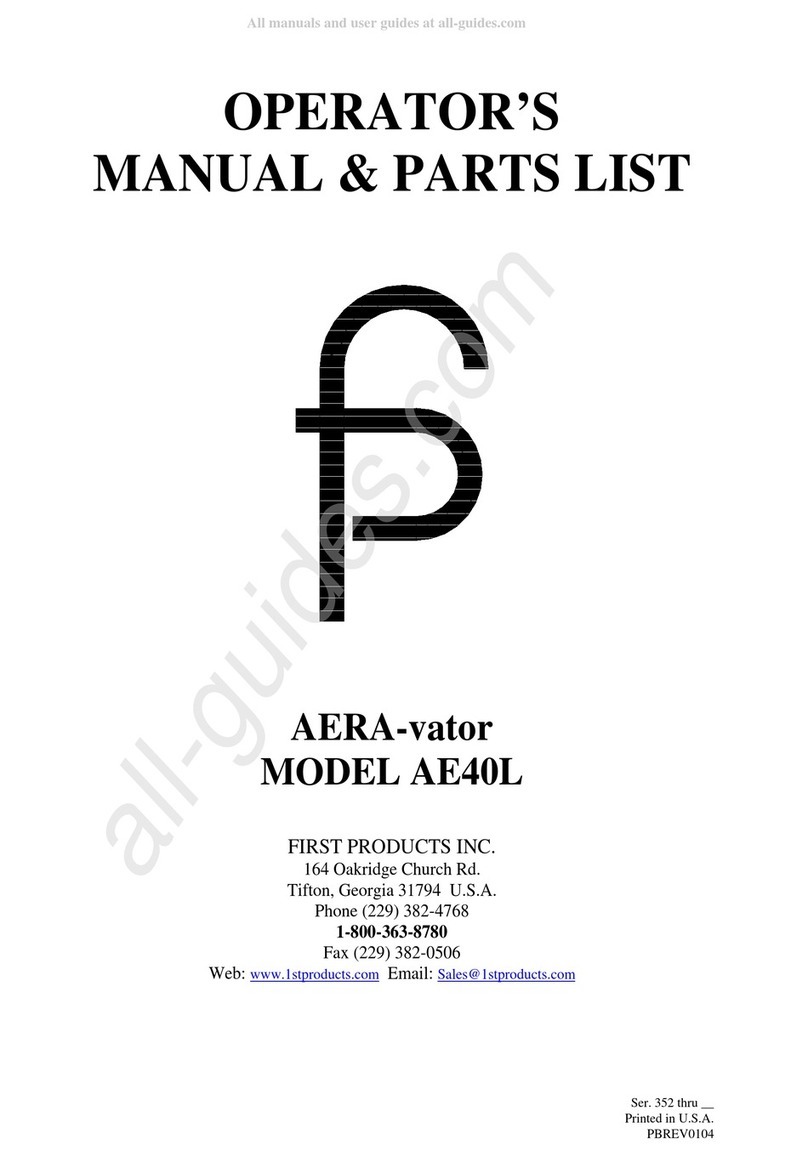
First Products
First Products AERA-vator AE40L Operator's manual & parts list

Curtis
Curtis 1JD2520AS installation instructions
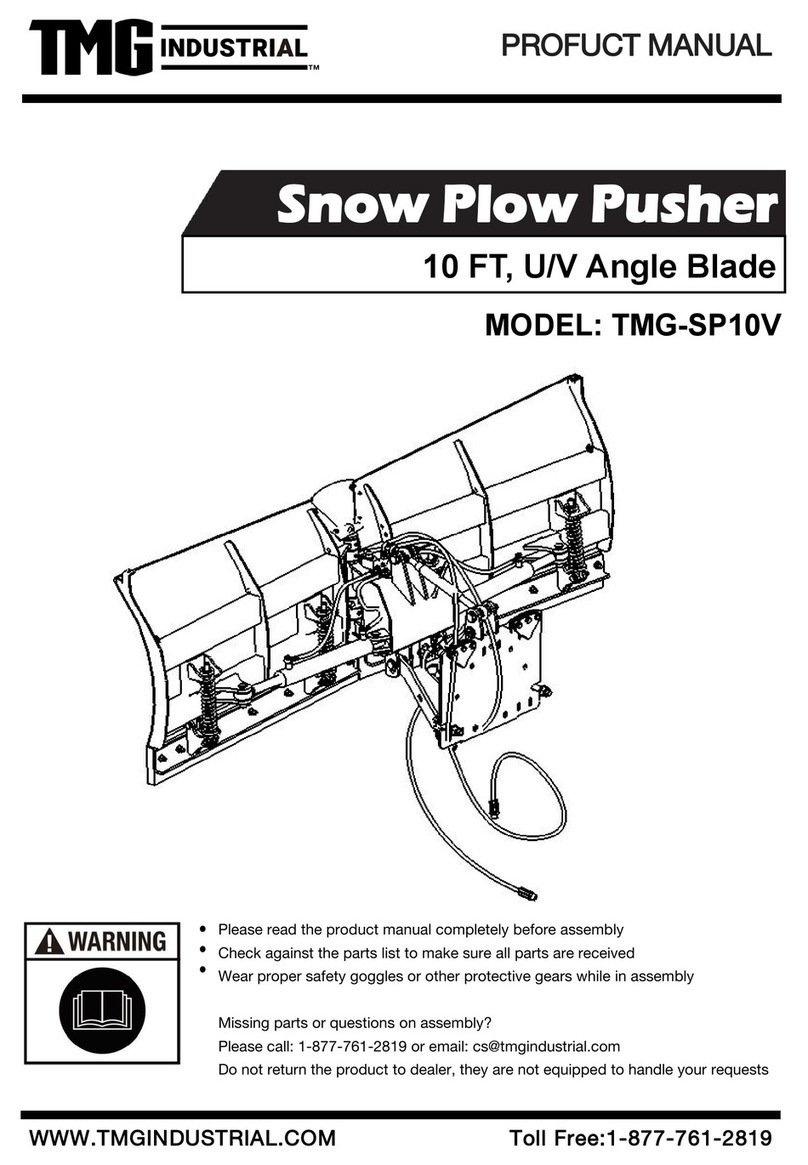
TMG
TMG TMG-SP10V product manual
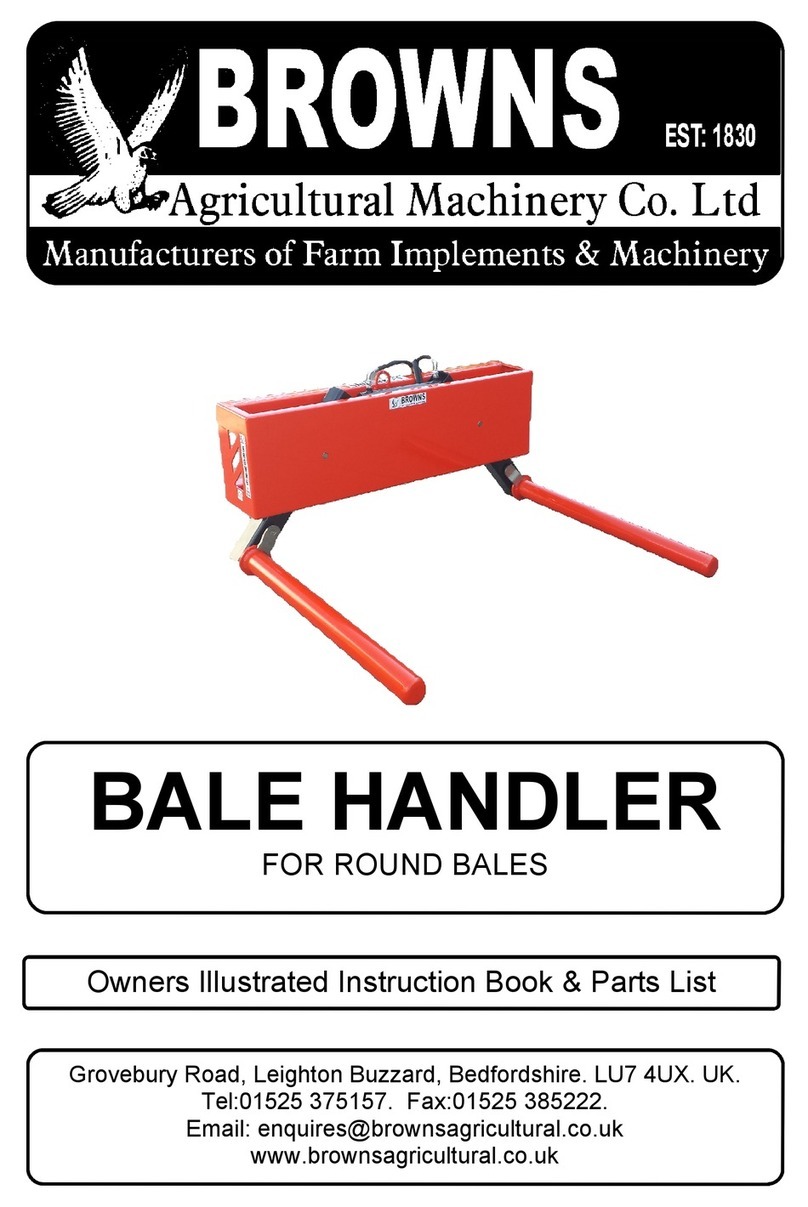
BROWNS
BROWNS BALE HANDLER Owners Illustrated Instruction Book & Parts List
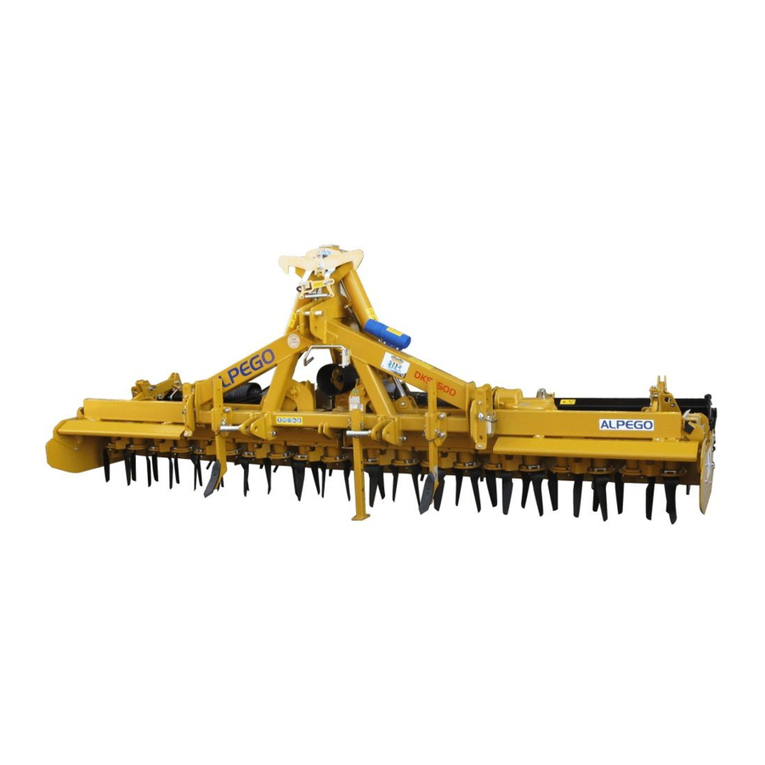
Alpego
Alpego DJ Series manual
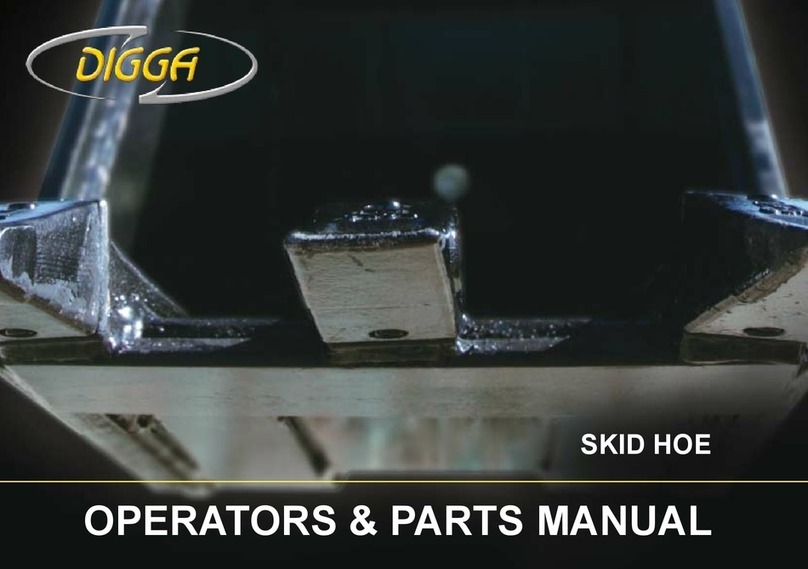
Digga
Digga SKID HOE Operator's & parts manual
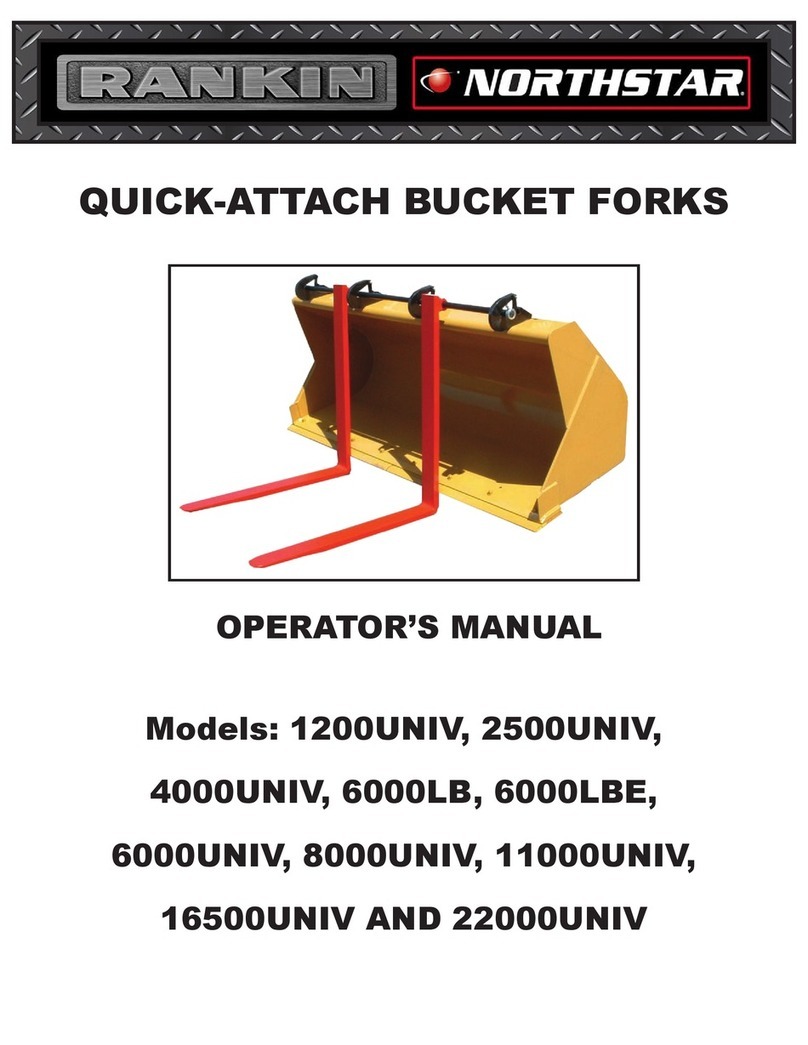
Rankin
Rankin Northstar 1200UNIV Operator's manual
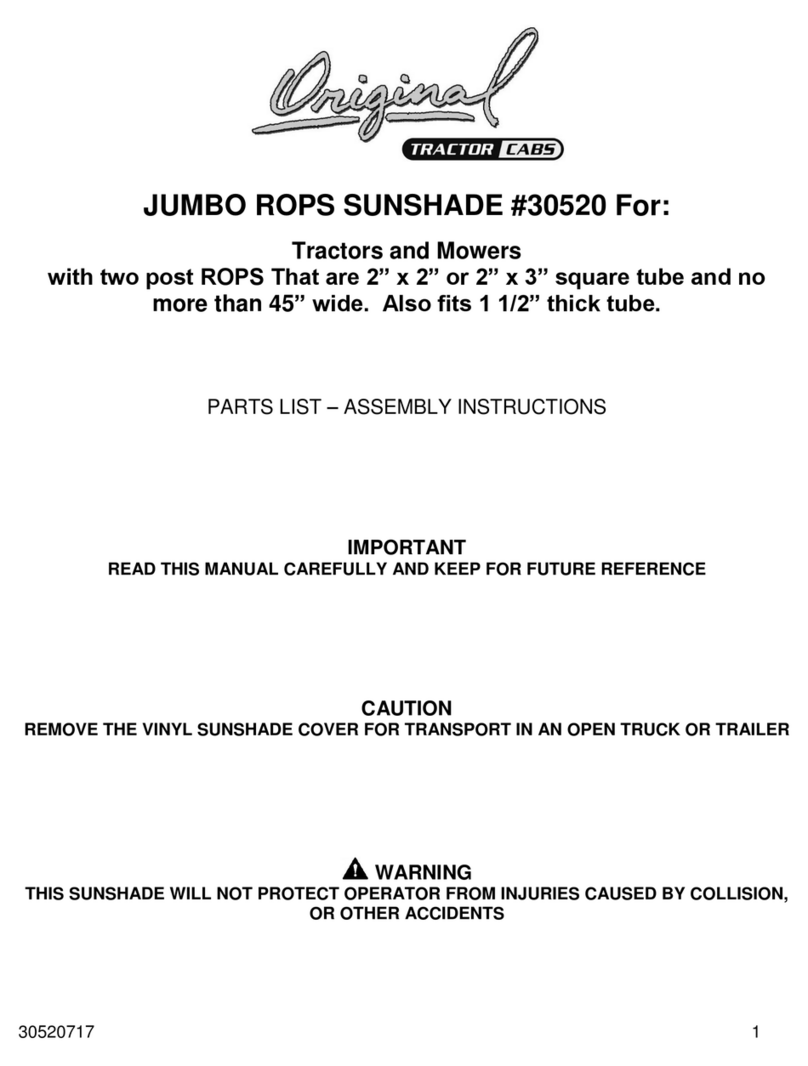
Original Tractor Cabs
Original Tractor Cabs 30520 Assembly instructions
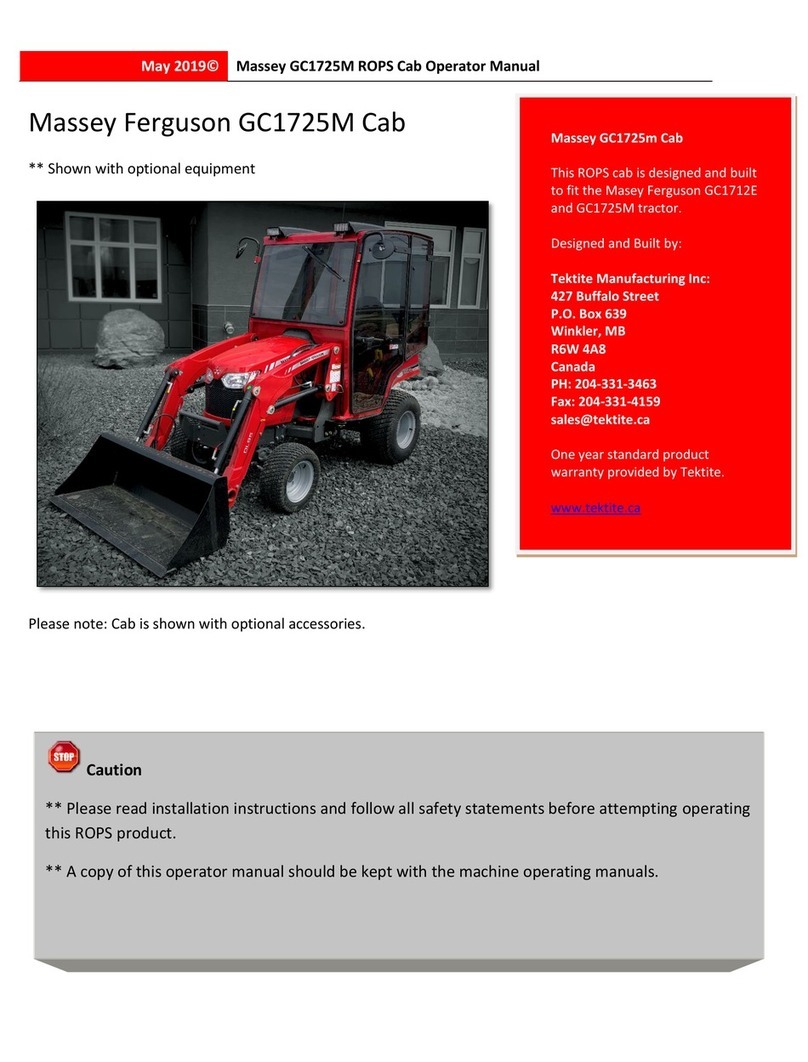
Tektite
Tektite Massey GC1725M ROPS Cab Operator's manual
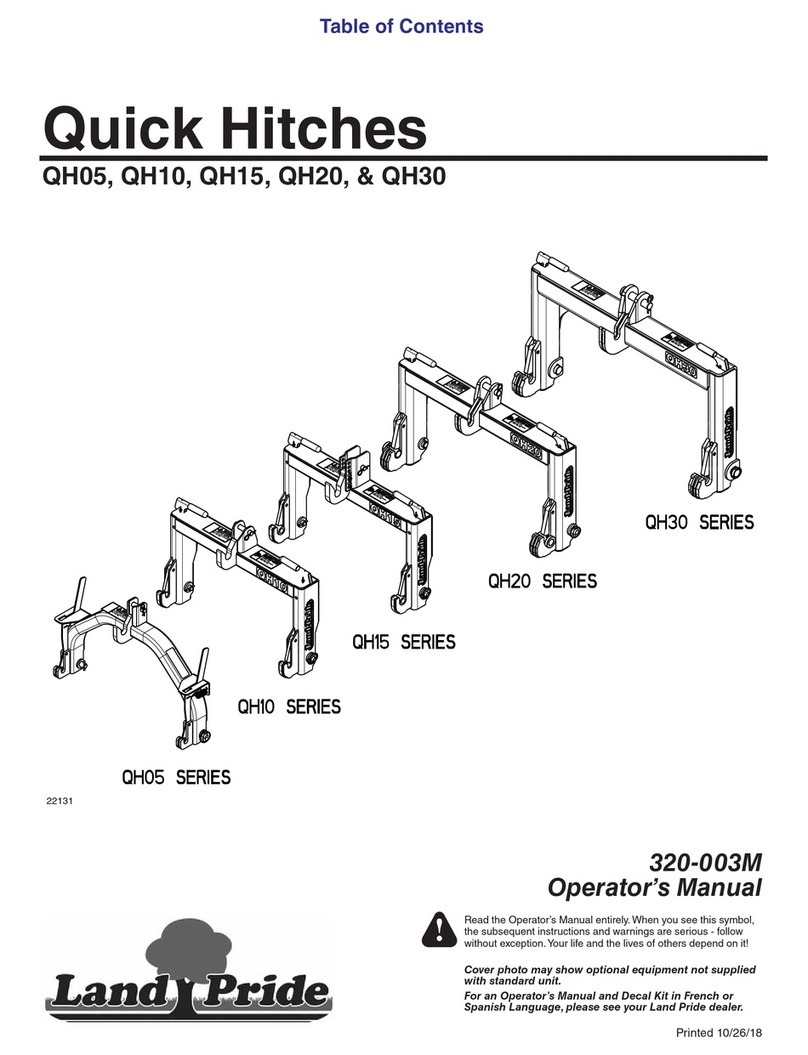
Land Pride
Land Pride QH05 Series Operator's manual

DR
DR Premier Safety and operating instructions
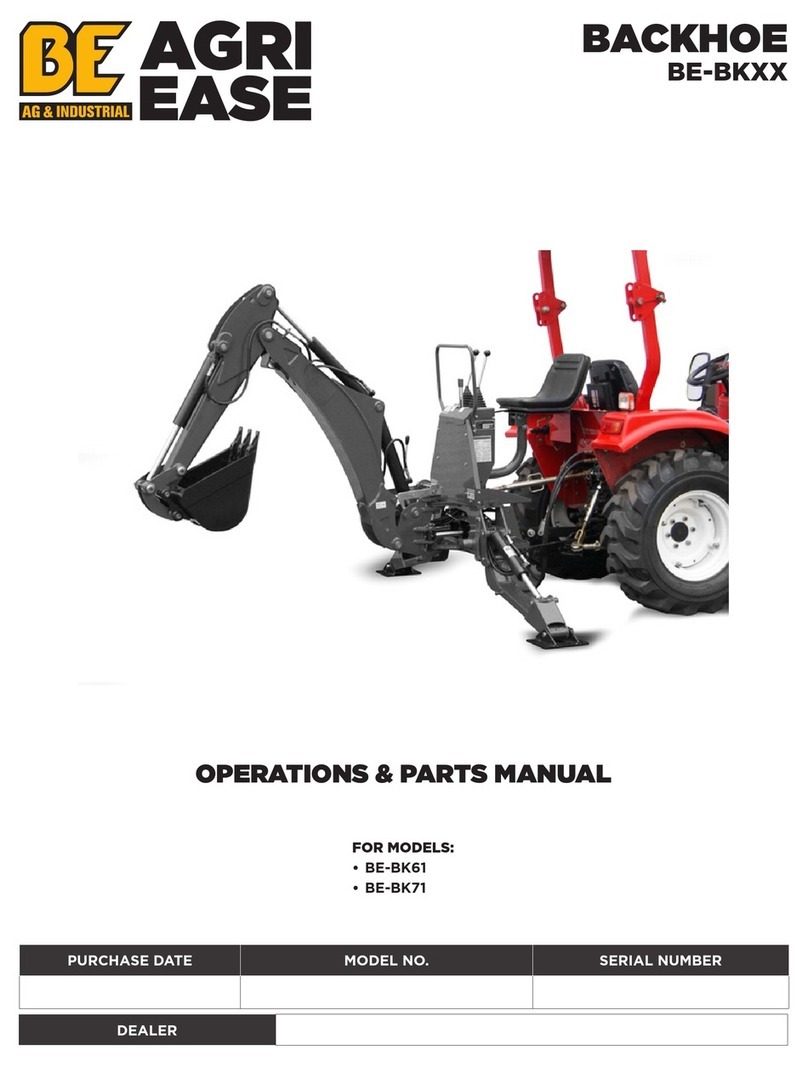
BE Ag & Industrial
BE Ag & Industrial BACKHOE BE-BK Series Operations & parts manual
